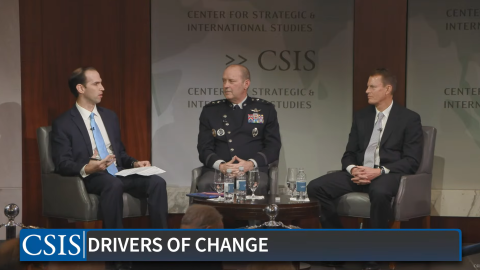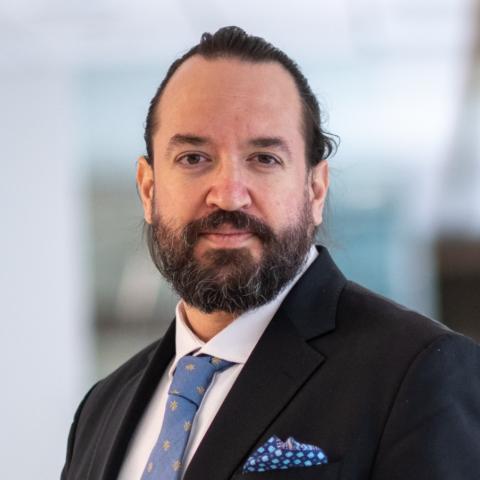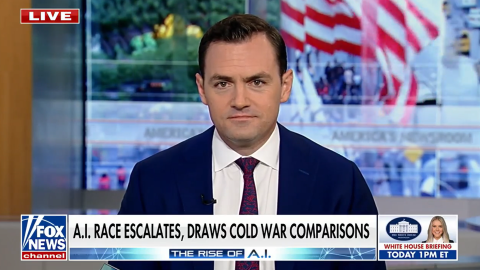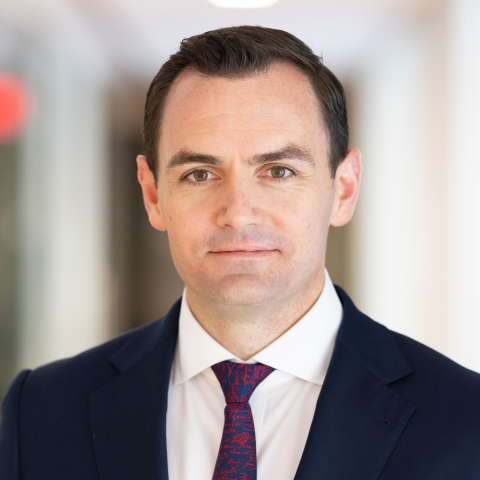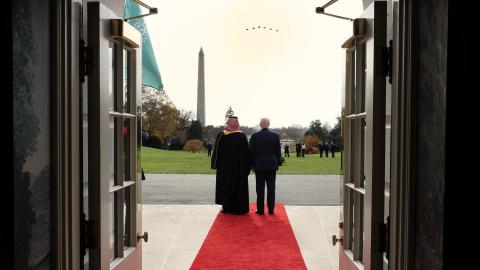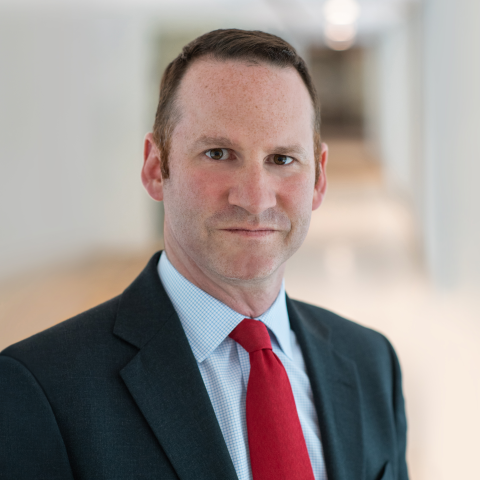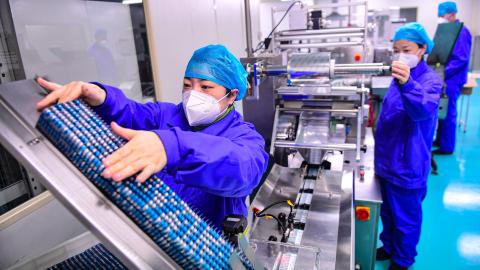
Vanguard of Manufacturing: Fortifying US National Security


Cofounder and CSO, Blue Water Autonomy

Head of Factory Operations, UNION

Founder and CEO, Volund Manufacturing

Cofounder and Head of Strategy, New Industrial Corporation

General Partner, New Industry VC

President, New American Industrial Alliance and Editor, American Affairs
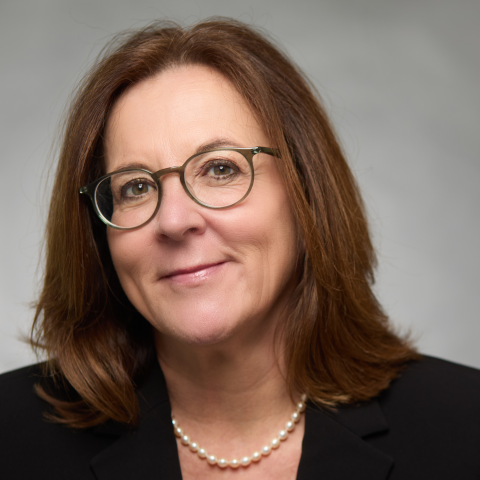
Senior Fellow
Nadia Schadlow is a senior fellow at Hudson Institute and a co-chair of the Hamilton Commission on Securing America’s National Security Innovation Base.
Hudson Institute’s Nadia Schadlow will host a conference on the future of America’s industrial base. The event will bring together representatives from new firms at the forefront of reindustrialization—companies working to address supply chain vulnerabilities, strengthen national security, and overcome institutional barriers.
Company representatives will discuss their experiences, how their firms have navigated obstacles, and what changes the United States needs to make to fortify its manufacturing base. Additionally, investors and manufacturing sector experts will outline the most effective frameworks for attracting private capital and building sustainable public-private partnerships.
Event Transcript
This transcription is automatically generated and edited lightly for accuracy. Please excuse any errors.
Nadia Schadlow:
Well, it’s a pleasure to be here this morning with my wonderful panelists. I’m looking forward to this morning very much, and I appreciate everyone taking the time today to come. So the origins of this event were, I’ve learned from so many of the people in this room, some of who we’re going to hear from this morning, and looking at this re-industrialization opportunity for the United States. And I thought that I really wanted to get a sense from people sort of on the front lines of this effort. So the organization of this today has a little bit of strategy behind it. We call it specifically the vanguard of manufacturing, people on the front lines of trying to do the rebuilding of the defense industrial base that many of us are talking about and writing about and thinking about. So they’re actually doing it. And I thought it would be really interesting to hear from three of these front line people what their experiences are, what they found. And then the panel to follow will focus on the capital, the money that’s needed to make this happen too, and the type of capital. And as many of you know, there’s a difference in terms of types of capital in funding software and hardware.
I’d love it if you all asked questions. I’ll do some questions initially, about 30 minutes, and then open it up to the audience. And then just following in terms of logistics, after the event around noon, there will be some food on the outside for a little light lunch for those of you who would like some. So we have here three panelists. Austin Grey, Austin first, co-founder and chief strategy officer of Blue Water Autonomy, an autonomous shipbuilding company. He previously served as a naval intelligence officer and volunteered, I just learned recently, to work in a drone factory in Ukraine where he gained firsthand front line experience of modern military production. So we’d love to hear something about that too. Eric Hostetler, founder and CEO of Volund Manufacturing. Did I pronounce it right, Volund?
Eric Hostetler:
Volund, yeah.
Nadia Schadlow:
Volund? Oh, it’s a soft . . .
Eric Hostetler:
Yeah, named after Volund the Smith.
Nadia Schadlow:
Okay, sorry. A company that produces the next generation of American-made attritable jet motors. Prior to founding that company, he cultivated a wealth of knowledge in engineering, management, and logistical knowledge and has worked at companies, I think, such as Anduril and Apple.
Eric Hostetler:
That’s correct.
Nadia Schadlow:
And then Russell Varone, the head of factory operations at UNION, a company that establishes modular, autonomous, and intelligence-driven factories to meet modern industrial demands. But also specifically I think you’re making munitions or setting out to do that.
Russell Varone:
Large caliber munitions.
Nadia Schadlow:
I’d love to hear more of that. Yeah, large caliber munitions. And you’ve worked at Tesla as well in the past.
Russell Varone:
Did some time with Elon, did some time at Zipline. Had my own construction startup for about five years.
Nadia Schadlow:
Okay, great. So why don’t we jump in with Russell. So tell us a little bit about UNION, about what you’re facing and what is UNION if we went down to visit it? I know that you had an opening about a month or two ago. I wasn’t able to attend, unfortunately. Tell us about UNION and what you’re finding as you’re working in this space.
Russell Varone:
So UNION is focused right now on large caliber artillery ammunition, 155 millimeter ammunition. We are a privately owned company, so we’re venture capital backed. So there are no, what they call COCOs, corporate operated, corporate owned factories doing it at this scope anywhere in the world. So we’re the first of this venture. Most of them are GOGOs, which are government owned, government operated, or GOCOs, government owned, corporate operated. So we’ve taken it upon ourselves to look at the space and say there’s a dearth of artillery ammunition. That is still what wins and loses battles. It’s still, you see FPV drones, you see exquisite weaponry, you see cruise missiles, but artillery is what moves the front lines. And honestly, artillery is cost per kill, the lowest cost thing out there right now. So when you look at war and economics, this is what wins battles. And the US has attritted that very, very largely over the last 15 or 20 years.
So we’re bringing kind of that Silicon Valley method of speed, technology, software, robotics to the hard physics of forging and machining and heat treating and painting. So we don’t get to cheat the physics, but we can cheat the manufacturing operating systems to do things at a Tesla-like speed. And we’re looking at building these factories much quicker. So we have a very, very quick capital cycle, excuse me, capital cycle. We have a very quick design and development cycle because everything we do right now is prescriptive manufacturing. We’re building to print for the military.
So unlike some of my other panel members here, we have a very, very specific thing to build that’s been built for 30 years. So we can’t cheat on any of that. We have to go through all the processes. But we are taking all of the accessory things, the things that are not value added, the time it’s not in a forge, the time it’s not in the CNC machine, and we’re drastically revamping that. And we think there is a tremendous amount of opportunity to do that across many factories. You just can’t cheat physics. But everything besides the physics, you should look at the requirements and really trim everything down. So that’s our thesis. And we’re spinning up a plant in a town in Carrollton, Texas, which is like northeast Dallas, and we’re landing equipment this week. So we took possession of the building May 1. We’re already putting in presses and painting lines. So we’re trying to show people that the industry can move fast when it has the right conditions.
Nadia Schadlow:
I’m going to ask some follow-up questions about neighborhoods that want or don’t want munitions factories in their neighborhood. But I want to first turn to Eric.
Eric Hostetler:
Yep. So Volund was born out of a long part of my career was in high volume consumer goods and experienced firsthand how you develop products for the manufacturing methods, for the price points you want to hit, for the volumes you want to produce at. And then the second half of my career was with Anduril Industries, my own machine shop, building aerospace and defense articles where that paradigm is kind of flipped where you get this set of requirements from the government, you go out and you work on it, you design, develop, you win your demo, and then people then turn to, okay, now how do we scale for production. And in a lot of ways, sometimes at that point, you’ve painted yourself into corner, it’s too late. And so we’re really kind of trying to marry the two and flip the paradigm of in propulsion in particular where people have designed for exquisite for so long that a small engine to try and push what we’re hoping to be is a low-cost cruise missile that costs a hundred thousand dollars when there’s no reason for it to cost that much. So we’re looking to actually bring the manufacturing into the front of the process to dramatically lower costs, dramatically lower lead times, and increase factory agility so that we can produce these things at scale much more quickly.
Nadia Schadlow:
So I will come back to a follow-up thinking about whether or not the DoD requirements process appreciates that flexibility or lets you be as flexible as you might want to be. And Austin.
Austin Grey:
So I’m picking up on a theme here of build things we know we need, jet engines, artillery ammo, faster and more scalable. And that’s exactly what, and I can see why Nadia lined us up like this, what we’re doing for ships at Blue Water. So America and the whole West has a massive shipbuilding crisis for a couple reasons. And at the same time, there’s this tech adoption revolution happening for drones and autonomous systems and cheaper distributed systems that’s not yet being applied to ships. So it’s sort of a natural solution if you can apply it to a ship-sized vessel. So as Nadia pointed out, and I’ll get my points here, two and a half years ago today, I was in Ukraine, I was working in a drone factory. The factory had 70 engineers, no BD people, no lawyers, no accountants, just 70 engineers as the whole factory. They just built stuff.
And I would go to the front line, talk to soldiers, think about what products and specs and features they need updated and then come back. And all as a volunteer and say, “Hey, this is what we’re seeing on the line, what we need.” And what I realized is that all of the speed and creativity and capability that’s coming out of Ukraine that all of us are seeing everywhere from TikTok to really thorough research that come out of think tanks in the Pentagon is that the drone thing is happening and it’s real. The mobility space is disaggregating. In space 30 years ago, there were a small number of really expensive satellites. Now there are tens of thousands of small cheap satellites. For computers, this block 20 years ago might’ve had a hundred computers. Now there’s thousands of computers within a thousand feet of us. That’s happening for mobility too. Drones are the air version of that. It’s happening on the ground with disaggregated cheaper cars already.
The ocean is a little bit harder for some reason. We’ve seen it with speed boats. We’ve seen it with these renewably powered sail drone type vessels. It hasn’t happened for ships yet because there are a couple of engineering bottlenecks we need to break through to make it happen for a ship-sized vessel that requires megawatts of power and all that. So we’re solving those technical problems. We’re building a ship that’s going to be mass producible. We want it to be the Liberty ship of the twenty-first century. And we’re working with a very large set of 80 suppliers and then a lot of the hardware and software that we design and build ourselves as well to put all the pieces together and get that ship on the water next year.
Nadia Schadlow:
Tell us a little bit about the Liberty ship just because not everyone in the audience might know that reference.
Austin Grey:
And this is a great reminder for me because I’m working on my product marketing, how do I brand this as something inspiring. In World War II, we had to get all of this material and food and everything across the Atlantic and the Pacific too. But in 1941, Britain is literally starving. They’re running out of ammo, they’re starving, they’re running out of Spitfires. We don’t even know which of those three things we should send first, Spitfires, food, or ammo, but you need to send all of it. And so American shipyards started building this really simple kind of ugly ship. Roosevelt called it the Ugly Duckling, but it was mass producible because it was very simple lines, it was very few components. They built one of them in four days. They built a lot of them in 10 or 20 days, but they just churned out so many of these ships that they could produce them faster than German U-boats could sink them.
And so we want to get to the point where we can have a very simple design that you can assemble quickly in many types of American shipyards. And we won’t ever match the Chinese on mass and production capacity in the Pacific, but we can at least have some numbers to create matchups where our ships only cost the same thing as a salvo of Chinese missiles and therefore they think twice about shooting those missiles at us. And the last thing I’ll say is that if we’re building ships like this, we talked about the requirements process a minute ago, if the Navy’s or the Army’s requirements are, hey, just build a simple 200-foot-long steel ship without any crazy speed or stealth or any of these extra features, we can build those in 40 different American shipyards. Now a Blue Water, a startup, or a small shipyard is never going to build a destroyer as well as Huntington Ingalls or General Dynamics can. We’re never going to build an aircraft carrier, we’re never going to build submarine. Those things are built really, really well in five or six different yards. We really can’t build more of them without massive investment. So we need to go find what the American industrial base can already build, design for manufacturing and then go churn those out.
Nadia Schadlow:
So speaking of that, and to the other panelists, I mean is there an intersection of the, well, a couple of things, but DoD as your primary customer, are you also looking at the commercial side of things? During World War II, there was this close collaboration between the commercial and DoD. And in some cases, obviously with munitions, that’s not really the case. So you’re probably a particular case. But in terms of the other two panelists. And then I would like you to respond to the DoD requirements issue. What I mean about that is that the Defense Department traditionally has set out such specific requirements for particular systems they buy that it effectively prevents you from adapting in real time and doing what the Ukrainians did, because they’re more concerned with you matching that particular system drawn this way than adapting as you need to go. And this is a clash essentially with the flexibility you all are trying to advance. So jump in.
Russell Varone:
I would say one thing. Obviously artillery is not dual use. Even though I see some big, in Virginia and Texas, these big fourth of July fireworks stands, I don’t think anybody’s buying large caliber ammunition for fourth of July. But the technology, when we look at these things, I look at like Isaiah Taylor over at Valar Atomics, I look at Radiant Nuclear, I look at Oklo, they are going to need high pressure fittings and elbows and valves. We’re focused on ammunition. But when I look at lumpy demand, when I look at things, I hope fighting stops. I would love all these things we make to be training rounds, but they’re not. But I look at that and I go, hey, we have the capability if needed, I could parallel up half the exact same line I’m doing for artillery for six or eight or 10 inch 120 pound flanges for steam or for nuclear, things like that that we don’t have here, that you may only see in Korea or Brazil or Germany or China. But we’re not going to fill our supply chain for new nuclear with Chinese parts.
So the production systems may be dual use where the product isn’t. That’s UNION right now is strictly focused on the ammunition space, but we see that. And that’s one way we say we’re not dual use, but we could be dual purpose. So that to me is a very interesting thing is that to level out that demand, but to have that exquisite skill of being able to provide those things. Because I know Isaiah pretty well. I don’t think he’s going to spin up a forging factory for all his pipes and his fittings and stuff. That’s not in his core technology. So someone needs to be there to hopefully step in and help them. And we look at, we have possibilities for that.
Nadia Schadlow:
Eric and Austin, in terms of thinking about dual use and how you’re thinking about your model. Because DoD is not always the easiest customer, right?
Eric Hostetler:
Sure, sure. So I don’t want to just say what he said, but the way we’re attacking our problem is really become a first principles approach to how do you produce defense articles at the speed and scale? What things make the cost and complexity of those things are what they are? And optimize and automate those things. And so we are building advanced factory automation for that scale. And after we’ve done that for jet turbines, the turbo machinery on space, the turbo machinery on nuclear, the turbo machinery on energy, high-end medical, there’s a wide variety of vital infrastructure industries that just aren’t quite iPhone high-volume type production that our automations, that our systems will be servicing. And like you’re saying, Lord willing, we are not in a hot war. We have replaced all of our exquisite munitions with the low-cost cruise missiles I’ve enabled in six or seven years, I hope that I’ve now building cells for producing all of these other things that are vital to the infrastructure, what we’re building here.
Nadia Schadlow:
And Austin, so is DoD appreciating your efforts moving toward flexibility and rapidity?
Austin Grey:
It’s such a timely question, Nadia, because the Navy right now . . . And so DoD has taken big steps to roll back JCIDS, roll back some of the joint oversight requirements. The Navy right now, the way they’re procuring the ship that we’re building and we’re in the competition, it’s kind of going through its process for that program of record, but they’re procuring it in an extremely flexible sort of low-touch requirements framework. And so the MASC competition, the program’s called MASC, it’s an acronym, launched over the summer. They did an industry day. Within 60 days, they put out requirements and received five-page white papers.
I’m the only non-engineer at Blue Water. I wrote the five-page white paper. I didn’t have to go through a hundred-page requirements document and take my entire engineering team off of building the actual vessel. I could just write the five-page white paper being like, yeah, this is what we’re building, and it roughly fits into these boxes of how much payload do you carry, how far do you go, do you have enough power, mainly just that, and is it going to be cyber secure, things like that. We don’t have to do all the paperwork. We don’t do all the compliance. We don’t have to change tiny little things in our engineering specs that create all this requirements creep. Look at what happened to the frigate program. They had to keep changing requirements because everyone wants their widget move to the left or move to the right and that changes and then the wiring has to change and then the cooling has to change and there’s all this requirements creep. So the way the-
Nadia Schadlow:
So you are seeing positive changes?
Austin Grey:
The way the Navy is procuring this right now is extremely fast and loose is the wrong word because loose implies sort of sloppy. It’s dynamic. And that’s I think a very, it’s a nascent good news story. They need to follow through and finish. They need to reopen the government, fund the programs, do their spend plans, and put companies on contract. But this is a process where the HIIs of the world and the Blue Waters of the world can both compete very easily without a lot of overhead. And so it’s good for the government, good for the taxpayer.
Nadia Schadlow:
So what else, what do you need from the government, or a couple of things, but what do you wish you had more of, whether it’s capital, or less of, regulation? Eric and I were talking on the sidelines. Sort of how would you shape the environment going forward in ways that could be helpful to people like you, the vanguards of this manufacturing effort, Eric?
Eric Hostetler:
So I think mean changing gears a little bit there, going into some of the compliance overhead that a lot of these companies are now dealing with, I think there’s potentially a number of different ways to kind of go about it. I think when you actually dig into NIST 800-171, which is the cybersecurity, how to defense manufacturing companies protect the data, the designs that we’re working with? You’ve got ITAR regulations, you’ve got FAR and DFARS, you’ve got this whole . . . Those are federal acquisition regulations and defense federal acquisition regulations. That’s all the laws that govern how do you work with other prime contractors and with the DoD specifically on contracts. And as one would imagine, it’s a tremendous web of overlapping rules. And I think that one of the ways I would see being helpful would be to have some sort of overarching organization of some of these regulations.
As you dig into them, I think a lot of people would love to just say, oh, we just have to deregulate and just get rid of some of them. Many of them, I think when you actually really just have a meaningful talk about what they are, they’re not meaningful to get rid of, they’re important. But I think maybe helping the people that want to move into the space either through subsidy or providing frameworks for achieving that compliance, by basically just coming alongside a lot of these manufacturers to work with them on achieving some of these things. When you look at CNC machining in particular, 50 percent of the machine shops in the US have less than five employees. The idea that in a five-person business you can dedicate one whole person to just compliance or just chasing some of these down is not really tenable. And so I think as the government, we have to find a way to come alongside people to help them do these things so they can participate in that marketplace.
Nadia Schadlow:
At the very least, almost at least one point of contact or a place where you could go to kind of understand. I mean, that would be kind of novel, interesting, and where you’d know. And yeah, that could be interesting.
Eric Hostetler:
Yeah, I mean as an example for the room, our company’s four people right now. I went and got a quote for working with an IT consultant to achieve some of the cybersecurity requirements that we need to deal with. And the first quote I got was a quarter million dollars.
Nadia Schadlow:
Yeah. And I see my British friend, Paul, in the audience. I think I read something once that the UK government, the UK defense budget spends about one percent of its defense budget on compliance on these issues for the US if they want to sell. Is that right? It’s something like that. I mean it’s a shocking figure.
Eric Hostetler:
Yeah. And for ourselves, we’re venture backed. We can build that into our financial models and account for it as part of the pay to play of what we’re doing.
Russell Varone:
But the small businesses can’t. Absolutely.
Eric Hostetler:
Yeah. It’s crushing to them.
Russell Varone:
And the problem with this is it feels like tax code. At the end of the year, you go look at your 1040. How much tax do I owe? I’m not going to tell you. Well, if I get it wrong, I’m going to put you in jail. But how do I know if it’s right? That’s like some CMMC requirements, a lot of these things are there’s no hard way to measure it. Are you in compliance? We think so. There’s some contradictory things inside of that. It really is hard for companies to do this because it’s been a hodgepodge of things of just trying to band-aid gaps. Hey, they find a cyber security gap. Let’s put this on top of it. And it really is Byzantine and it’s hard. And we’re lucky enough to be enough velocity and a big enough venture play that, to Eric’s point, is like we can budget that. But if you’re someone in Iowa with an eight-person machine shop, how do you get into that? You might be really good at exquisitely machining titanium or reactive alloys or different things, but you’re just not going to go after that. You’re going to go after commercial things. You’re going to go after something a little bit simpler.
Nadia Schadlow:
Austin, did you want to . . .
Austin Grey:
Yeah. A really nice apples to apples comparison of the compliance IT specific burden for defense companies versus non-defense is so my co-founders have been through 10 or 20 different startups over the years, all commercial. One of them built the Roomba, one of them was in Amazon, all commercial. And they’re normally like, hey, your first IT hire is probably between 50 and 80 employees. That’s when it gets complex to scale your IT. I was doing IT. We had 15 employees and IT was already too complex. I was trying to do some early CMMC type stuff, it was taking up half my day and I’m the only person facing the government managing relationships here in DC. And so our IT guy was our hire number 16, and that’s compared to . . . And so one, that’s one 16 of our entire payroll is someone doing IT and compliance. And then two, a normal commercial company would make this hire at 50, 60, 70, 80 employees, almost four times later when they’re one eightieth, they’re one sixtieth at the company. So it was a real good apples to apples for me of how much earlier you have to spend a lot of resources there.
Eric Hostetler:
I think that experience, that tracks very commonly with everything I know in the defense tech world.
Nadia Schadlow:
It seems like you could take AI as one tool to reduce, to identify the overlapping requirements, to simplify, and then to provide a reasonable package of what’s needed to-
Austin Grey:
Yeah, and we got the requirements, we had to go implement it. You had to go literally install locks and logging on your physical security and set up cameras and reconfigure your networks and all that. And it was the implementation.
Russell Varone:
Blue gold networks, you have to have dual networks in your shop, a blue network for normal use, gold. So there’s a lot behind-
Nadia Schadlow:
And the gold is for classified or-
Russell Varone:
Yeah, sensitive information, yeah.
Nadia Schadlow:
Sensitive information. Right, right, right.
Russell Varone:
Luckily we don’t have anything classified. I don’t want to go down that road.
Eric Hostetler:
And then as you’re trying to develop custom MESs, they handle this sensitive data, how do you run those MESs through your factory in a compliant manner?
Nadia Schadlow:
What’s an MES?
Eric Hostetler:
I apologize. Manufacturing execution system. So the software that controls what work is going to the floor, what order it gets done in, what are the materials, how they’re moving around. So in our case, you’d have the blueprints or maybe the NC files-
Nadia Schadlow:
G-code.
Eric Hostetler:
The G-code, exactly, of what’s going to the CNC mill. Well, that is the data of how to make this thing. It’s important data to keep secure. And when you want to pursue some of this high-end automation, how is that moving through your company?
Russell Varone:
How do you share it with a sub-supplier? How do you share it with the machine vendor to say, “Hey, I’m having a problem with this tool movement or this path, help me.”
Eric Hostetler:
Precisely.
Russell Varone:
And if they’re not, and if you get someone that’s an overseas supplier, it becomes even more difficult. They have to have a USF entity set up to help us work on our G-code, like we’re doing something very, very high tolerance or very, very high power. So it just becomes, there’s this just level of barriers that people don’t see, that they’ve implemented the regulations without understanding the impact.
Nadia Schadlow:
A starting point might be, and then I’m going to switch to some supply chain issues, but a starting point might be to ask 10 of you sort of how they see the possibility of simplifying some of these processes. Right? My sense is you probably don’t get asked a lot by DoD, okay, what would you do to simplify or improve these processes? But that could be an idea of something that Hudson could take on. So anyway, in terms of thinking through.
Russell Varone:
The parallel in that is when you get your 1040 form, it says the average American spends 28 hours preparing a 1040, 1040-A. You see that the government, I think OMB tracks that. It’s like it’d be really interesting to people to go in, hey, a sub-50-person manufacturer, how many hours if you’re doing defense do you spend on compliance, just to get a sense of that.
Austin Grey:
You’d have to do a form though and add another 45 minutes probably.
Russell Varone:
Yeah, without a doubt.
Nadia Schadlow:
Well, so let’s switch a little bit to supply chain issues. So in one sense, you all are here because you’re trying to improve and reduce the vulnerability of American supply chains by manufacturing here. But in another sense, you’re sort of possibly victims or have to deal with vulnerable supply chains in terms of the components that you might need that we don’t produce. So you’re sort of in the middle of that. And also in terms of transparency, do you know where all of your supply chains are? So let’s just sort of jump into that a little bit. Austin, so are you getting what you need fast enough? Do you know where all of your components are that you need?
Austin Grey:
So we know where they all are. We’re still in the zero-to-one phase. It takes quite a long time to build a ship. We’re doing it fast, but it takes some time. The thing that’s going to be hard to scale are the large power electronics, two to 10 megawatt switchboards, electric motors. Propulsion for ships, always an issue scaling because it’s really bespoke. And we’re smaller than a big cruise ship and a lot bigger than fishing boats and yachts. And so that’s a challenge. That’s why there’s a line in reconciliation for many hundreds of millions of dollars, just buy a bunch of propellers. They know that’s an issue.
Those are our core supply chain issues. And I think every time an aspiring founder or investor comes to me and says, where is there something we should go build or work on, I’m like find an area in large machinery where there’s only one supplier for a critical component. And like artillery, there was only one supplier for shells a few years ago I think. Find area with only one competitor and create the other competitor and you’ll do just fine. And there’s a lot of places in the American industrial base right now. And right now-
Nadia Schadlow:
That’s the case.
Austin Grey:
Yeah. And I think for heavy machinery, all the megawatt scale electric stuff is where I’d start.
Nadia Schadlow:
And what about are you impacted by some of the critical mineral issues right now?
Austin Grey:
It’s so downstream. I mean, yes, but it’s so downstream from us that it affects the OEMs building the engines or building components that need a system component that has a battery as a subcomponent of it and things like that. But it’s pretty downstream for us, so it’s less of a core issue.
Nadia Schadlow:
And Russell, do you have what you need to make your munitions or energetic materials?
Russell Varone:
It’s what you need to build a factory. Because if you think about the valves, the controllers, a lot of those things that there are, there’s magnets in those things, all of that, so to Austin’s point, it is very downstream. So if you dial into anyone’s supply chain and say, elementary, where’s the neodymium coming from, we have that answer. And so it depends upon how reliant you want to be or how stringent you want to be to all the ways back to the element. Did that element come from an ally country or did it come from an adversary? You’re not going to like the answers on most of those parts right now. So if this cutoff that just recently happened does play out for long-term, we’ll see that come into the supply chain rapidly, and that’s going to be a pretty interesting choke point.
But the thing I would like to add is when you talk about supply chain is you think, show me the incentives, I’ll give you the results. Supply chain is really all about balancing money on books. Steel mills would run continuously. If I operated a steel mill, I’d never shut it down, but then I’d have this giant glut of inventory that would land on my books and I would get taxed for. So there’s perverse incentives to say, hey, how do we build a robust and secure supply chain? I need 10 or 12 inch thick steel plate that’s half the size of this room. No one keeps that at inventory when I call for it. It’s eight to 12 months to get that to build a press because of the incentives on how inventory is taxed and handled on balance sheets. So if people want to say, look at the industrial defense supply chain and say, how do we become more reactive, people are going to have to get into that and say, how do we disincentivize or not penalize inventory strategies?
Someone’s going to game the system always, but the government right now, it just doesn’t make sense. Everyone is just in time because budgeting and financial reports and your taxes every year as a company are based on having nothing on your books, being as cheap as possible, where there’s no incentives to propel us, like the castings that are needed, that special bronze alloy, the equipment for that. So there needs to be some realignment of those incentives. Companies would actually fill that need if it was beneficial. It’s like look, if you have 30 million pounds of this specialty material at all times, we’re not going to tax you like we normally would. And then you could be able to do that. And then all of a sudden it’s just like calling up DoorDash, hey, I need this special bronze alloy.
Austin Grey:
So you’re saying set a threshold for, yeah.
Eric Hostetler:
And just to follow on with this, my whole career in consumer goods, it was exceptionally common to go through your supply chain, go through your bill of materials, identify critical line items, long lead, expensive, et cetera, and you would hedge against those things. So rather than having this binary argument for or against stockpiling, rather than maybe just stockpiling all of the completed 155 munitions, maybe we’re just stockpiling the raw material that’s vital to this, or the companies that make the presses that are vital to reinvigorating that line when it’s needed. It happens all the time on the consumer good side. I think starting to have some of those more nuanced conversations of what does stockpiling actually mean on the munitions, that would be very meaningful.
Nadia Schadlow:
Redefining it. But actually, you’ve also then just pointed out a role for government is in rethinking the incentives to allow companies or to encourage companies to do what you just pointed out. And another theme then drying out is that supply chain transparency is potentially there if you want it as a company. If you want to know, it’s more and more possible with AI today and the data we have to follow. I mean, because years ago, the conversation was, well, we don’t really know where everything’s coming from and there are just thousands and thousands of components, but my sense is-
Austin Grey:
It was just phone calls also. You would literally have to call them to get updated. Yeah.
Nadia Schadlow:
So now we’re at a stage where you could know if you want to know, but knowing could also create some complications as well.
Eric Hostetler:
Yeah, and I think one of the other nuances I’d want to point out at this whole situation is I think a lot of times we talk about supply chain or bottlenecks in this macro sense. For my engines in particular, the hot half of the engine, which is exactly what it sounds like, the back half where all the fire comes out, those are almost exclusively produced from what they call super alloys. They’re going to be nickel or cobalt based alloys. Very, very hard to come by, very difficult to machine. Casting them, you have to do it in a complete vacuum so there’s no opportunities for impurities. My co-founder and I attended the Investment Casting Institute annual conference two weeks ago to really deep dive on the supply chain. And we started going through the room. And Investment Casting in particular is a known problem. 200 foundries in the US. And you say, “Okay, how many of those foundries have an AS9100,” which is the aerospace quality program, “how many of those foundries would be suitable for even making aerospace parts?” And you go to 40. You say, “Well, how many of those 40 actually work with the super alloys that we’re talking about?” Nickel and cobalt-based alloys, and they have to pour them in a vacuum, and they do all these. Between eight and nine. And so all of a sudden you’ve moved completely away from this macro idea to where one CEO or one owner, that guy’s vacation schedule can affect supply chain for people. It’s no longer, it’s literally a personal topic at that point.
And I think this is not uncommon in supply chains for all these things, I think. So finding a way to actually dive into some of those details and move away from the macro level kind of discussions on this and really address some of these is vital as well.
Austin Grey:
I guess my question there is eight to nine to me sounds like a competitive market because if there’s eight or nine people you’re competing against, pretty competitive. If there were two suppliers, big problem, right? Or three. Is that not a capacity or what’s the issue?
Russell Varone:
Go to Shenzhen and swing a dead cat and you’re going to hit 22 Investment Castings in a 600-meter radius. Just the density, sorry for this swing. I just love that phrase, right? But I love cats. Anyhow.
Eric Hostetler:
That’s exactly what it is. So we actually, and we’d been trying to contact a lot of these people. I mean, it was a little humorous and we actually had to corner some of these people in an elevator. “Oh, we would love to work with you.” “Oh yeah, that’s great.” “You guys don’t pick up your phone.”
Russell Varone:
Oh, you know Cameron Shiller, right?
Eric Hostetler:
I do.
Russell Varone:
Okay, good. Cameron’s fighting a good fight on that.
Eric Hostetler:
Yeah. And it makes sense at the same time. So if these people have work till infinity backed up, so about half the foundries closed up during COVID and scarier than that, the one thing I learned was that 80 to 85 percent of the mold makers for the wax closed up during COVID. So right now, the lead time on getting the tools you need to make the castings, you’re 11 to 12 months just to get one iteration of a part. And so there’s,
Nadia Schadlow:
There’s still a lot to do.
Eric Hostetler:
And you’ll get similar stories when you talk sand casting, you get similar stories when you talk die casting, you’ll get similar stories when you talk injection molding. There’s a lot of industries that are similar to where they’re backed up. And I’m not going to say they’re complacent, that’s not quite fair. But financially it takes a lot for these people to turn to a small guy like myself and say, “Yes, we want to work with you.” And so, again, I’m not typically one to try and have the government solve too many problems, but finding, I don’t know if it’s tax incentives or what it would be to work on some of these development programs with people because it’s vital to what we need to do.
Nadia Schadlow:
Okay. I’m going to turn to the audience for some questions, but I’m just going to ask you one last question. So if you had advice to give to others who want to sort of be on the forefront looking for the companies that are needed to Austin’s point where there’s only one supplier buying a facility that’s 20,000 square feet, 200,000 square feet, any one or two pieces of advice? Russell, you want to?
Russell Varone:
The thing that we talk about supply chain is labor and talent. I don’t like to talk about people as numbers, but I’m very, very adamant that we need to make manufacturing a desirable thing. I want to have 13-year-olds come up to me say, “Hey, I can’t wait to come work for you. I want to do this.” So that, I think it’s us. And I do a lot on Twitter. I do a lot with the folks from Reindustrialized and a New American Industrial Alliance. I think we need to really get people to see that if . . . My mother was like, “You’re going to college.” I went to college for manufacturing, which was the cheat code or she didn’t like that. But I think we need to get that publicized again and see this. And I see I’m, I’m on a train in New York and I see come build submarines.
So I see these glimmers of hope. We need to bring that back into the national conversation. That is a key important to supply chain that’s even harder than steel, harder than cobalt, all of those things. So I think that that becomes how do we get those innovative things to populate these factories, to get the new ideas, to get the people that are going to start startups and say, “Hey, I figured out how to solve Investment Casting,” or, “I figured out how to solve this welding problem.” People have to want to be in the space. Everybody’s wanted to optimize clicks and speed credit card transactions and go work at Meta because they see what the down the back end of that looks like when they succeed. No one has seen that back end of what it looks like when manufacturing succeeds. So that might be slightly off-axis, but I think that’s really critical to the supply chain is just bringing in the massive talent.
Nadia Schadlow:
Eric?
Eric Hostetler:
I agree wholeheartedly. I think there’s a lot of commentary on things you can do with the downstream symptoms after your manufacturing culture is dead, which is where we’re at today. But I think generally speaking, I watch Union and then Russell in particular, Chris at Hadrian, I think there’s a lot of very, very loud voices that I love just ringing the bell about how awesome it is to make things, to watch metal being cut and melted and pounded and it’s just amazing stuff. And I think getting more of that message to our kids is important.
Nadia Schadlow:
Austin?
Austin Grey:
So I’ll say something different and it’s build a differentiated product. There are so many new companies and so many new products from existing companies that are just throwing a design at the same thing. And in my space, a lot of small drones, there’s a lot of small aerial drones using not nice jet engines like yours. There are a lot of small, every company now has a speedboat USB, like literally even the ground companies have them. It’s crazy. If you don’t have a differentiated product, you’re not going to stand out and you’re going to do the opposite of the thing I said a minute ago, which is like, go find somewhere where there’s only one supplier or one provider of that thing. And now if that’s an aircraft carrier, don’t go compete with HI on aircraft carriers, that’s a lunatic move. But if there’s one type of engine or shell or component, go make that and then we’ll have a second or third supplier and that’ll be good for the country. And if your product is differentiated and it works, the sales won’t be as big of a problem.
Nadia Schadlow:
Thank you. So I’d love to take some questions. Just let me know who you are. Just name and question. I don’t know if we have . . . Do we have microphones or, I guess not. Okay. I’ll take this gentleman up here in the blue shirt.
Daniel:
Okay. How’s it going, y’all? My name is Daniel, I’m from the Yorktown Institute, and this is my question to y’all. What is the message? Yes, what is the message to the younger generations, to the high school students, to the college students? Why should they care about the defense industry? Why should they care? How is it going to affect them and why should they begin to study it in the high school classrooms and the university classrooms when they have all these other social issues that are prevalent on the media and social media? Why should they focus on the industry? What would you tell your kids?
Austin Grey:
I’ll give them two reasons. So one is the labor market is shifting, the US education labor complex over-indexed on liberal arts degrees, languages. I say that as someone who went to a tiny liberal arts school and studied Arabic in college and had a great time. And it’s shifting back towards let’s do some more engineering and let’s build some stuff. There’s an amazing book out right now called Breakneck about how China’s society is engineering-led and engineering-centric, and ours is led and centered on lawyers. And here we are in Washington DC, right in the world capital of lawyers in the Beltway. So I think it’s a really interesting discussion about that tension, our competition.
The number two reason is that going into a career in manufacturing and building capability here at home for high school students or any young person is the best way of guaranteeing that they don’t have to go inside of artillery range or inside of the range of an adversary drone. It’s much more fun. It’s hard work in a factory. It’s much more comfortable and much more fun to do that than go to a trench in Baku. Easy choice.
Nadia Schadlow:
Thanks, Austin. I’m in the back of the woman in the pink, the reddish.
Jessica Stephens:
Hi, I’m Jessica Stephens. I’m with American Defense International, previously with the House Foreign Affairs Committee where I worked on the AUKUS legislation. I have a question about sort of pulling on thread that Nadia had mentioned earlier. We saw it sort of with AUKUS Pillar I, the challenges with building up manufacturing, building up a workforce. And I’m just wondering how your industries maybe contending with the issue of this movement towards clean development, manufacturing processes, preventing pollution, that industry thing that has been such an issue historically. How much does that impact our ability to sort of grow our workforce, grow the manufacturing cycle, and how do you address that? Thanks.
Nadia Schadlow:
Yeah, great question. And AUKUS Pillar I is the US-UK-Australian agreement to work on technologies together. So great question.
Russell Varone:
Well, so I’ll try to answer that. So when I look at this, we talk about environmental stewardship. People, plant, and planet, right? Environmentally stewarding our people, the physical plant that we have, and the planet we all live here. We looked at this and then I hope I don’t throw shade at anybody, but we were originally going to open up in southern California. When I got to the site, I did some assessments, I was like, “Look, that’s an eight-year legal fight. It’s going to cost us $16 million and it’s just never going to happen.” We pivoted to Dallas and I had environmental pits for an entire 250,000 square foot factory in 89 days. And we’re going to be just as clean as some of the Southern California Air District requirements. We’re putting on regenerative thermal oxidizers for our volatiles. We’re putting all this filtration in our water treatment. We have heavy metals, we have to zinc plate these rounds, we have to do different things.
We have a no nonsense, straightforward regulatory environment that cares, but that wants that business to be there. And then as juxtaposed on an environment that’s a regulatory environment that has absolutely gone through the mirror, Alice. It is just so bizarro. So we pivoted a very, very big effort because of that. But we had wanted to be closer to the talent in Southern California to the El Segundo’s. But we just looked at the structure as a company. It would’ve killed us. We would’ve been dead before we were born, but we’re going to be just as clean. So it’s not driving anything better. It’s just feeding into this industrial regulatory complex. So I think that it’s easily doable. I would have a problem. I spent many years in recycling. I spent many years I was at Tesla, so I really do care about this stuff. But it’s if you are able to manufacture and you can manufacture just as clean. You just have to think about why are the regulations like that? And we ran into that in California and then we just, “Okay, well, we’re not going to fight that. It’s not a winning battle.”
Nadia Schadlow:
Eric or Austin? Any-
Eric Hostetler:
Well, we’re bummed you didn’t join us in Orange County. I would’ve loved to have you there for our engines in particular. Actually, one of the things I did at Apple was color was paint, high-end paint. So very, very familiar with what it takes to do that. Similarly with plating and some of the other things. And I’m fortunate to be able to say most of those things don’t apply to the product I’m making, and thus I can, I’ll say, get away with making what I’m making in Southern California.
Nadia Schadlow:
It’s even tripled if you’re dealing with AUKUS where it’s not just US regulations, it’s other countries. And the complexity of that is probably pretty tough. Any other questions? Yeah, gentleman in the back?
David Gossick:
Yes. I’m David Gossick, independent consultant now formally with the US Department of Commerce across Asia and with the US Chamber. My question is that the National Institutes of Standard and technology has its manufacturing USA program that’s been around about 10 years, which has a number, I think 13 advanced institutes on different kinds of advanced manufacturing technology around the country. NIST also has its manufacturing extension partnership program, which is supposed to, I think, help SMEs address a lot of the problems that you’ve raised this morning. My question is, one, do you have any interaction with those groups and are they helpful? And two, if they are not, is there a role where you can take that existing base and shape it into a support program for the kind of expansion of defense manufacturing that we’re talking about?
Austin Grey:
So this sounds a lot like-
Nadia Schadlow:
Great question.
Austin Grey:
Yeah, great question. I’m from the government. I’m here to help. Pretty concerning. We can build this stuff just fine and I’ve had no interaction.
Nadia Schadlow:
These are manufacturing hubs that are around the country in theory. I mean, I’ve read about them, I haven’t seen them, but it’s an interesting question about the utility of them. I mean, do ecosystems have to essentially appear organically or are they something that the government needs to come in and say, “We shall have an ecosystem here”? Not sure.
Eric Hostetler:
I can’t honestly say that I’ve had any interaction with them. I just have a long background in manufacturing just at the companies themselves.
Russell Varone:
A little bit. I think when you’re really bleeding edge, that may be where they come in. But the default thing is like, I don’t need another cook in my kitchen right now. And that unfortunately is, that’s US industrial policy, right? Is like, “Hey, let’s get this done in spite of policy, in spite of regulations,” versus, “Hey, let’s get this done with regulations, with policy.” That move fast ethos, I don’t want to bring someone in that’s like, “Okay, maybe I’ve now tripped into something and all of a sudden I’ve inadvertently slowed myself down.” So the risk is not worth the reward there for most of that. And it’s unfortunate because there’s a lot of amazing talented people. There’s some things I want to do next generation. I don’t know if I can have a partner that doesn’t operate at that . . . We’re venture funded. We have to move very fast, and we have a very, very tight window, obviously in the ammunition to be able to provide that deterrence. Right?
Nadia Schadlow:
So one or two more questions. Tsiporah, and then the woman in the back.
Tsiporah Fried:
Thank you very much Nadia, and thank you gentlemen for this really amazing presentation and very inspiring initiatives. So I’m Sephora Freed. I’m a senior visiting fellow at the Hudson Institute, and formerly I was from the French Minister of Defense. And I have a question that is related to mass production, a public command, and your business plan. Lessons learned from Ukraine showed us that we need to shift into a mass production, sometimes cheaper production and faster production. But to my great surprise, when I spoke to one of the major French defense industries from the industrial base of defense like Thales, Medea and others, they told us within negotiations that they would not shift into mass production unless they have a consolidated public command because they didn’t want to take financial risk. So I would like to know, how do you deal with this, especially considering the problems of budget that we have in France, and you have here also, which brings uncertainties. So how do you deal with that? Do you wait for a consolidated public command? Do you anticipate? Just how can you deal with that?
Russell Varone:
Well, I’ll speak from UNION. I think UNION is in a really interesting spot is that we’ve positioned ourselves, artillery ammunition is, there’s probably a 10 to 15 million round deficit of what most countries would like for a defense stockpile. So we see that, and right now the western world maybe has 200, 250,000 rounds a month of capacity. Don’t quote me on that, that’s just me from our meetings. So you could imagine that’s a six or eight year deficit. So we look at this and we actually are not doing anything for US government right now. We’re doing all overseas allies. So we have a little bit of insulated for that lumpy demand. So we’re looking at that way. We haven’t waited for a signal from the government. We see the need in the market. We see the need for the defense of the West, so we’re stepping into that.
We’re also engineering factories that are a little bit more nimble that I can turn up and down without massive layoffs. So if I have to go into, if there’s a winter of artillery purchasing, we can still survive and have a baseline and not have to worry about closing the companies. But that required us to engineer an entirely different kind of manufacturing chain inside of that factory than most traditional places have done, because it’s not very economically viable to open up a forging shop if you know that demand’s going to drop in two years. So we’ve built that into our business model. So we’re not waiting for the signal from US government. We love the US government. We want to provide anything they need, but we’ve started out with allies that may not have the ability to produce for themselves. And we’re also looking at those partnerships to dial in. And hey, smaller countries may want their own organic demand. We’re potentially looking at helping them do that same thing maybe on a little smaller scale than what we’re doing in Texas.
Nadia Schadlow:
Austin, Eric, any comments? I mean, part of this goes to also the commercial side of a particular business.
Eric Hostetler:
I think similarly for the size turbojets that I’m producing, there’s a deficit in the market right now. I see a deficit of minimum 7,000 units in ’26 alone. And then on the other side of the coin is we do have business development people monitoring where those programs, where that government demand stems from upstream and obviously watching very closely where we see that demand going to flourish into actual contracts.
Nadia Schadlow:
So there was a woman in the back that had . . . Yep. Yep, Pat. Yep. Thanks.
Pat Ramsey:
Hi. Thank you all. My name is Pat Ramsey from the Institute of State Effectiveness. There’s been a lot of discussion about speed, and today the speed of rhetoric is very fast and far outpaces the speed of change even. So how have you fortified your processes, products, policies to, in light of both real shocks, but also just general instability, balancing being proactive without necessarily being reactive, understanding that some of the rhetoric might not materialize?
Nadia Schadlow:
Anyone want to take that?
Austin Grey:
I think for small companies, you have to pick the right product first. It’s a really, really important early decision. The right team, the right capital partners. And so if you were building an artillery shell that was one millimeter wider, you would’ve picked the wrong product and there’d be no market and demand for it. If I was building a ship that was a little slower, the surface warfare officers who controlled the Navy’s budget over the Pentagon would not like that, and that would not be something that could sell over a long amount of time.
So all of the zigs and zags of the budget cycles, the government shutdown, the capital markets, the market tanked on Friday with the tariff announcements back up a little bit. All of those zigs and zags, you’ve got to be able to weather them. I think it’s a really good question, but I would say for a small company, it starts with your very early product team capital choices, and you need to be operating in a big market where there will be deficit and demand for a sustained amount of time that’s not just a widget that somebody wants because of a meme hype cycle. It needs to be something where there’s real sustained demand for over a long amount of time.
Nadia Schadlow:
Which you might get to, just interjecting, forgetting moderator to panelist, a sense of identifying the question, the right question from the start-
Austin Grey:
Core problem.
Nadia Schadlow:
. . . of the problem that you’re seeking to solve. And if it’s a meaningful problem and one that’s likely to be a sustained problem, then you’re seeing something about the market you’re in. Yeah. Well, I think we have room for one last question, but then otherwise we can take a five-minute break and reconvene for our second panel. I can’t see.
Austin Grey:
I see a gentleman right here.
Nadia Schadlow:
Oh, Tom? Oh, okay. And then the gentlemen, so just ask both of your questions in tandem and then we can get answers.
Tom Duesterberg:
I’m Tom Duesterberg, another senior fellow here. I did run a trade association called Manufacturers Alliance for Productivity and Innovation for 12 years. And this problem of the cultural antipathy or indifference to training people to get into manufacturing. I wonder if there’s not a similar problem in American capital, because China has this narrative that they are on top of the world and they are going to compete in all sorts of manufacturing areas. And they do, they subsidize the heck out of it. And so I even see in Germany the same sort of problem, not only at the worker level. But my question is at the capital markets level, is there a little bit of, despair is too strong a word, but understanding that maybe it’s a fool’s errand to put money into manufacturing? I mean, you guys are all entrepreneurial and doing incredible things, but do you have trouble raising money?
Nadia Schadlow:
Well, Tom, the next panel are three people representative of that capital world.
Tom Duesterberg:
But I’d like to know what people-
Nadia Schadlow:
Yeah, ask, but then I would like the next panelists to take that on too.
Eric Hostetler:
So my experience thus far, and I’ve actually even seen this shift since I founded the company in January. I just see basically a learning curve in the capital side where I think there’s been, it’s a little stereotypical, but so much sass for so long that they’re starting to look at what are the actual signals that show you a manufacturing company is going to be successful. And they’re obviously different signals, and I see more and more VCs and PEs getting into that, and I see it heading that direction very, very quickly.
Austin Grey:
So we’ve raised $65 million in the last year. We’ve raised from some investors who have been doing defense and physical world transformation for quite some time as their main thesis. The last round we raised, our series A, was led by Google Ventures. Google Ventures has not played in defense at all to my knowledge. Google walked out of the Pentagon in 2018 during Project Maven because the woke software engineers, or not all of them had this issue, but some of the software engineers did not want to kill terrorists with their software. So Google said, “Hey, our employees are revolting. We’re going to punch you out here.” Google is joining the fray in defense and physical industries. They’ve been working physical industries a lot. How did Waymo have it right? That’s a massive physical transformation of our world.
Companies like Google, companies and people who have spent the last two decades building the American consumer industrial base, right? My co-founder built the Roomba, the vacuum cleaner for your house. The other guy did the warehouse robots for Amazon. These are ultimately consumer economy-focused products. These people and that type of capital is entering the hardware, the manufacturing, and the defense space. And that’s a lot of the American economy. That’s a lot of capability, and that’s why we’re going to be okay. So I think I would challenge sort of the premise of your question around the antipathy that you alluded to. And it’s a hard thing to pin down. Antipathy is probably the wrong word. There might be maybe ambivalence.
Russell Varone:
The way we see this is are you an optimist or a pessimist?
Austin Grey:
Yeah.
Russell Varone:
And America has always been optimistic. And I see this and I’m building in Dallas, and it’s interesting, we have painters, we have welders, we have pipe fitters, concrete guys. They love the mission. They’re like, “We love this country.” And again, a lot of us are coastal. I grew up in New York, worked in California for a long time. But there’s this groundswell of when you go out and you talk to people, there’s this, it was almost like it was embarrassing at some point to be a patriot. And well, that is swung, right? There’s some implications of some things when needles go too far one direction or the other. But I think that from VCs I talked to, they’re self-selecting. They’re there for a reason. But they’ve also come to this, one of the guys, Aaron Slavdov in re-industrialized effort, said, “Look, now you have to move atoms.”
We’re getting really good at moving bits. It’s almost becoming, well, AI is doing that much easier. We’re moving atoms and people at the end of the day, that is the world we manifest in. I don’t know where it was said, but if you pull something out of the ground and you add value to it, that’s truly the only value creation. You take iron ore, make iron. When you’re transferring money, when you’re doing clicks, when you’re optimizing financial transactions, that’s just moving the money around in the pool. Who’s bringing the money into the pool? It’s the manufacturers, it’s the refiners, it’s the people that are adding value. You’re taking, if you look at the Elon Idiot Index, he always says, “What is the absolute value of the raw materials?” And an artillery shell is a hundred dollars a steel, $3 of paint, couple of dollars of brass, some coatings, and a heck of a lot of energy. Whatever that number is, it’s a relatively low idiot index from what that thing sells to.
But I would imagine, Eric, you’re doing exquisite things. Their products are probably 10 to 50 times more expensive per pound, but you’re still building something that you’re getting a very, very high conversion of value in that. And I think that when you look at this, you have to be an optimist. You have to look at this saying, “Look, we need to create value.” That’s how the country grows and not shifting around the existing pieces. And it comes back to you have to be optimistic to want to challenge that.
Nadia Schadlow:
That’s a good note to end the panel. And now I have the sub tick Vanguard of Manufacturing Adding Value. So that’ll be the next year’s conference on this note. So hopefully everyone can mingle a little bit. As I noted, five minutes, we’ll sit back down and then at noon we will have some food after the second panel. Thanks so much.
So it’s a pleasure for the second half of our Vanguard of Manufacturing Panel. Money Matters to the previous panel. And here I’ve tried to bring together a group of individuals who can talk a little bit about the role of capital, which obviously matters. The manufacturing doesn’t happen without capital and the types of capital we need. And even though we didn’t plan it, Tom Duesterberg, my colleague, had asked the last question, was quite a great setup for the current panel.
So I would like to introduce Patrick Hunt to my left. He’s a general partner at New Industry VC, an investor deep tech hardware startup. He previously worked in strategy and commerce roles at Rivian. He’s an engineer by training and has developed hardware for military cargo planes and Mars missions, which I just learned. And I met Patrick at Reindustrialized. And it’s a very cool conference that Julius has helped to found and Peter Meyer. And so it really was an important event in bringing all of this together.
So I have Peter Meijer, co-founder and head of strategy at the New Industrial Corporation, which was the original starter of Reindustrialized and the new industrial Alliance, and I think one of the early firms to see that the type of capital, the color of money matters, and you and your colleagues have set out to think about how to invest in these companies at the intersection of venture and infrastructure. And you’re also in the Army reserves and had been a former congressman from Michigan.
And then we have Julius Krein, president of the New American Industrial Alliance, a multi-sector trade association dedicated to ensuring America as the industrial leader of the world. He serves as editor of one of my favorite journals, American Affairs, and I look forward to jumping in.
So I think, actually, why don’t we take each of you to talk a little bit about how you see this world of capital and intersection of manufacturing. Julius specifically also wrote a really interesting article in the Commonplace Journal on a sovereign wealth fund. So I definitely want to draw that out. It’s not a concept that we talk about a lot in Washington, but Patrick, why don’t you go ahead. How did you start your firm and why?
Patrick Hunt:
Sure. So like she said, I built Rivian for eight years. Then I went to this unicorn battery startup that had just raised a lot of capital, spent it very quickly and had a less successful trajectory than Rivian had. And to make sense of these two really different experiences, decided to write my own guide to building deep tech hardware startups and figure out just what advice I have and why people find this challenging. And when I was done, I had a framework that I thought was really useful and decided to build a fund around these insights. Teamed up with a brilliant partner of mine who’s been a friend for a long time. We’ve got this kind of two-part thesis for how we evaluate startups and kind of think about investing. And it’s absolutely tied to the last question from the previous session.
So we have these two ideas, narrative command and operational mastery. Narrative command is how a company can get unfair advantages by structuring the discourse in their vertical and building the vocabulary that everyone else is going to compete on. Tesla’s the best example of this, but there’s a lot more examples, and it is kind of generalizable outside Tesla. And then operational mastery is how you kind of fulfill that promise with execution.
Narrative command is this great lens to think about a lot of Domains, not just investing in deep tech hardware startups, which is what we do. And so if you think about what’s going on in American capitalism right now, I do think there’s a big narrative around we’re going to innovate in physical areas. We’re going to grow really fast in these areas and build really big, important valuable businesses. And so I think the narrative . . . I mean, there’s some doomerism around China. I think that competition’s very real, and it’s concerning. It’s sparking the right types of anxieties. And you can see in the names of our organizations that there’s something new happening in industry. And I think a lot of people, like some of the best minds in the country, are reacting to that challenge in a really great way. So I think we’re part of building that narrative. I think the United States maintains the best narrative around how capitalism is supposed to work and where the opportunity is. And that opportunity is mostly here.
Nadia Schadlow:
Peter, you’re at the intersection of defense, Army reserves, Congress, and Michigan.
Hon. Peter J. F. Meijer:
Well, and to build on that point, one of the challenges you see that folks who embrace the narrative of re-industrialization and they’re like, “Yes, this is important. We need to reshore some of these industries. We need to take advantage of advances in manufacturing capabilities, sectors that went abroad because of a competitive labor rates in another country.” Now that’s going to become more automated and more roboticized, great, we can bring that back, combined with a lot of the struggles that we saw initially during COVID and during the war in Ukraine.
And now with China ramping up their export restrictions on areas that are critical to US defense on how those extended supply chains, they may have helped decrease costs in the beginning. Now, they’re introducing vulnerabilities that our adversaries can take advantage of. So it’s both an economic imperative and national security imperative. The challenge, and this is where the folks who embrace the narrative feel like they get really smart. They’re like, “But aha, how do we actually shift now our financing ecosystem that’s used to the B2B SaaS,” right?
And when we say B2B SaaS, that is shorthand for software tech. Very, very low on capital expenditure. It’s not capital intensive. It’s just operating cost intensive. When you are starting a business in that domain, it’s very easy to scale up. You have to get maybe more office space, maybe more server space, hire more engineers. It’s kind of a linear progression. When you’re in the manufacturing space, you go from small run foundry or small facility that is doing proof of concept, that’s demonstrating your technology works. Great, now you have someone who wants to buy it or you have a market that you’re going to demand and it is not a linear scale up.
Now, your company is worth maybe on paper, 25 or 50 million and you’re like, “Oh crap, I need to build a 100 million dollar facility. I need to build a 200 million dollar facility.” And so, if you are using the Sand Hill Road model, the kind of traditional venture capital to private equity, the angel to seed to series A to series B, to series C, that’s what, on the venture capital side founders are used to, that’s what they know and that’s where most of the money is at the moment. What that means then is you have to raise to build that 200 million dollar facility. You need to have a valuation of your company now around 400 million.
You need to do a large series B or series C raise. So you’re raising the valuation, you’re diluting the owner’s share, and all that money coming in is pretty expensive equity, that is expecting a significant return. Those companies are fundamentally using their intellectual property as collateral for a physical built facility. No other industry does that. That is not the way that US manufacturing was stood up. And part of that is because we lost this middle market financing, the banking growth loan, lending industry, the industrial institutional support that really existed prior to the global financial crisis.
But then, when Basel III came out and the liquidity ratios for these banks got tightened, they said, “You know what, this may be stable returns, but it’s going to be eight, nine, 10 percent, or this is nothing that our investors are going to love, so we’ll leave this sector.” And that’s really where we’re stepping in. Our company tries to get a little bit of the venture exposure in the Topco, but fundamentally works with capital-intensive industries to say, “Hey, take it off your balance sheet, so you are able to unlock the lowest cost of capital for that. We are infrastructure project developers.”
That’s not my background. I was military humanitarian aid, legislation or legislative branch and now, on the financing side. But our infrastructure project team works with companies to unlock that cheap capital so that again, they have the best chance of having a tech-like uplift to their Topco without having to be saddled with the larger capital-intensive assets on their balance sheet. And if anyone has a better idea of how to financially support the re-industrialization movement, I love the intellectual debate, but every single major transformation of the American industrial base to date, has been matched with innovation on the capital side.
Not just carrying forward what sort of the legacy financing ecosystem was, but saying, “Hey, how do we look at this project? How do we break down the relative risk of each component and how do we then match it up with capital that has reasonable expectations of a return, relative to that risk?”
Nadia Schadlow:
So Julius, tell us a little bit about what you saw a need out there to create this new American Industrial Alliance and then a sovereign wealth fund. What is it?
Julius Krein:
Yeah. Well, first I’d just like to say the last time I was here was maybe 2018, 2019 with Arthur Herman, author of Freedom’s Forge, beginning these discussions on the industrial base. And at that time, I think by the end, the audience got to a good place, but at the beginning, they’re like, “What are you even talking about? Why is this a problem?” We’ve come a long way since then, but there’s still a very long way to go. And I think if you look at the areas where China has grown into a dominant position, they actually serve very similar financial characteristics.
Whether you’re talking about critical minerals processing, ship building, telecom hardware, generic drug APIs, these are all capital intensive cyclical businesses. And if you are an investment analyst in any American or Western financial firm, you know to stay away from those businesses. And you got to add on to that in addition to those inherent characteristics that you’re also competing with subsidized Chinese companies and so on. And in these businesses, you’re looking at IRRs of five to 10 percent and every equity investor wants 25 percent. And so that is why we lost them, over 30 years. Financially, it was not attractive to capital and SaaS and software was.
That has changed or I totally agree that there’s been a huge shift. Venture capital, not surprisingly, has been first to sort of answer the call, but venture capital equity, as we were just saying, is not optimal for capital-intensive production facilities, can only go so far. The large corporates, as we heard on the last panel are also entering this area, but you’re still missing, I think, the private equity, private credit, public markets bond, bond markets that we really need to provide the hundreds of billions, trillions of capital needed for scale-up financing. And the math for those players too often just does not work. And that’s where I think policy needs to step in.
And when it comes to sovereign wealth fund, there was an executive order early on in the administration, instructing treasury and commerce to put together a strategy for a sovereign wealth fund. And we also have new or existing mechanisms, Office of Strategic Capital, Energy LPO, DFC, EXIM Bank, others that currently exists, you could debate whether you should give them more money or stand up a new vehicle. The advantage of a new vehicle is kind of created to address some of the unique challenges of today, whether dealing with critical mineral price volatility or certain other investments that some of the other existing vehicles weren’t designed for.
But at the bottom, we’re going to need a policy layer to bridge the gap between the return expectations of later-stage capital markets investors and what these capital-intensive cyclical industries can do. Loan guarantees are an obvious mechanism for that, but it’s not the only one.
Nadia Schadlow:
I just want to draw out a little bit of what is the fundamental concept behind a sovereign wealth fund and how is it different from other big baskets of capital out there? And then, I’d like to turn to Peter and Patrick to comment on how do you see these sources of government funding and how are they helpful to you or not helpful to you. But Julius just like a 1.0 Version of the concept behind a sovereign wealth fund?
Julius Krein:
Well, most Sovereign wealth funds, the name has come to refer to typically countries with large export balances. Usually, some kind of natural resource, Saudi Arabia, Norway, UAE, that has a huge foreign currency surplus that they cannot recycle internally. And so, they need to set up a fund to deal with all this money, making investments abroad somewhere. That is obviously not the US problem. In the US case, we should really think of it more as kind of a development bank, a development bank for strategic industries. There was a bill that was almost co-sponsored by, at the time, Senator Vance and Senator Coons in 2024, that sort of had this model.
I think that could play a kind of role or be the baseline for any new vehicle. But in the US context, you sort of ignore the name Sovereign Wealth Fund relative to . . . It’s not the same as what Abu Dhabi is doing, but think in terms of a sort of development bank that could provide . . . could make it possible for private equity, private credit, public markets, investors, and by extension other equity players, to enter into these categories, which are now sort of, they’re just not going to meet their return hurdles in any large number.
Nadia Schadlow:
So to that point, Peter and Patrick?
Hon. Peter J. F. Meijer:
And I will, there’s some . . . Because I’ve spent a lot of time trying to break down a lot of the action we’ve been seeing from the Trump administration, especially because it’s an area when you start talking about fundamentally issues of corporate finance that a lot of the political commentary and media ecosystem is just not well addressed to handle, and that is not a knock on them, it’s just a very, understanding the difference between-
Nadia Schadlow:
Body of knowledge.
Hon. Peter J. F. Meijer:
Yeah, between a grant and a debt to equity conversion. And that’s fundamentally where I think this administration has taken things and why I’m also very befuddled at a lot of folks who otherwise respect and value their opinions, seems to break their brain a little bit. But the Intel investment just went from, “Hey, listen, this is maybe too risky to be a loan, instead of treating this as debt that would’ve just been massively forgivable.” It was essentially a grant in the way it was going to be structured. It’s like, why don’t we convert this into an equity stake that at least the American taxpayer could see an upside to?
Apparently, that’s socialism now, according to some. That’s where I try to wrap my head around some of the labels being placed on things that in my mind are very reasonable and incredibly defensible. But where the previous panel was talking about that, that hyper-cyclicality and that was some . . . in a lot of these markets, especially more commodity markets, that’s something the Chinese have taken massive advantage of. They would flood the market to depress the price, to put American producers of raw material out of business. And then once there was no American producers without raw material, they would then jack the price up again and insure their own dominance.
Those are areas where I think it is . . . where we need to appreciate from an industrial policy standpoint that there is not this firm separation between church and state, between a national security issue and an economic issue. And we’re having something like the MPU materials deal, where the government on the Department of Defense side said, “Hey, we will be your off take partner.” We will sign a take or pay contract for up to X number of thousands of tons of your raw material, of your refined material at this price. Those are places where theoretically, yeah, the government is taking a risk on future forecasts of those prices.
But that also is then creating the stability and creating the market where those companies can then go to a lender and have the private industry side fill everything else out. That’s where I think between . . . is that a sovereign wealth fund? Do we store some of those raw material reserves or whatever we’re procuring and a strategic reserve that then can be sold and help finance? There’s a lot of different layers to this, but I think it’s important to, from the top level, understand this is in reaction to the way in which our adversaries have been taking advantage of the market and manipulating it. Now, we need to make sure that our companies are not the victims of that manipulation going forward.
Nadia Schadlow:
So Patrick, and also specifically on the government taking direct equity stakes in companies, but I’d love to hear overall.
Patrick Hunt:
Sure. So just to be clear on what venture capital is, I mean we’re investing at pre-seed and seed stage companies to use simple numbers at something like a post-money valuation of like 20 million dollars. And we are selecting companies that we think can then exit for about two billion dollars, so a 100 X growth, and we’ll get diluted in half along the way, and we see a 50 X on our money. That’s what we’re interested in. That’s possible when you’re investing really early. As a company grows, the kind of return on capital is going to fall over time as the risks fall off, until eventually, it’s a say, public company. And so, along the way, we need lower cost of capital for these businesses to work. So both of these models are kind of essential for us to be successful.
Nadia Schadlow:
The government offers that lower cost of capital.
Patrick Hunt:
Right. Well, we need all kinds of creative financing along the way to separate some CapEx investments from Topco investments. I mean, that model is wonderful. And then government support I think does help all of this. Whether it’s in the companies that we’re investing in or parts of the supply chain that they’ll need, I think this is really important. I think we all love the invisible hand of capitalism and making sure the market just works. I think there are key choke points where you need to take a heavy hand and just make sure that the market is working the way we’re all going to need it to.
Nadia Schadlow:
So I mean, ultimately, the common theme over the past few years has been that government can attract private capital to this domain, and that’s an important role for government to play. And now essentially we’re debating the different tools by which government does that, is that accurate?
Patrick Hunt:
I think so. The Inflation Reduction Act had its tools and it spurred a lot of investment and some of that has fallen away and different tools are being put in place. And I think it’s just . . . What’s important is that everyone has kind of enough time to adjust to whatever the new set of tools is going to be, that we run this long enough so we can all put some operations and investments in place and that it is structured so that it’s ideally pulling private capital in off the sidelines. We think of three big risks when we’re thinking of a startup. There’s technical risk, demand risk and execution risk.
And demand risk is I think where the government can . . . There are of course other risks in financing risk and whatnot, but demand risk is a place where the government can send a lot of important long-term signals. And I think that’s really important.
Nadia Schadlow:
By buying, by purchasing goods from companies and-
Patrick Hunt:
And making clear, here’s what we’re going to want, how much of it we’re going to want, what we’re going to be willing to pay, and the kind of competitive environment that we’re going to structure. These are going to be the rules of how you’re going to compete, the clearer, the better.
Hon. Peter J. F. Meijer:
And then, that doesn’t even need to be at a significant premium to where the market is right now. You’re just guaranteeing a set of stability so that that company is able to look at it and secure financing that isn’t then pegged to commodity risk and commodity fluctuations. And these can theoretically also be places where . . . Especially if it’s a guaranteed price minimum. Well, a guaranteed price minimum is one thing. If it’s a guaranteed, were to purchase amount at that plus like floating price, federal government may actually make money off of that because they’re putting on a different side of that currency trade, long term.
Patrick Hunt:
Yeah, that’s right.
Hon. Peter J. F. Meijer:
But they just have to get out of their own way. And that’s why . . . Maybe we’ll talk about NEPA and refining and all of the . . . There are light-lift things that are totally within the executive branch, and then there are . . . which I don’t mean to diminish the challenge inherent in them, but that are a lot easier to solve than dealing with the regulatory environment that Congress is wholly inadequate to . . . Even when it’s like an 80/20 from a member’s standpoint. Coalitionally, there are still enough stakeholders on one side of the aisle to torpedo things.
Nadia Schadlow:
And so Julius, if a sovereign wealth fund comes to be, how do you see a situation involving, where companies would get in front of it to sort of compete for the money or would it be sort of a marketplace of options and opportunities? And then, related to that, for all of you, you’re in this sector, which is not purely software, not B2B. I mean are there . . . do you have a plethora of companies out there that are available to you to invest in, but Julius a sense of how might that play out, so it would be a creative process?
Julius Krein:
Yeah. Well, first of all, I think the administration may be sort of backing into a sovereign wealth fund because they are taking very ambitious, aggressive actions in this domain, which I’m wholly in support of, but buying equity stakes, I open the newspaper every day, it looks like the US government just bought an equity stake in something. Where do those reside? What are you going to do with them? Who’s going to manage that? At a certain level, at some point, you’re just going to need a sovereign wealth fund to deal with that. But the actual model itself, you have to manage, on the one hand, it being politically responsive and accountable, but you cannot have it flipping back.
It can’t be the Democrats win and it’s all green energy and Republicans win and it’s no green energy and it’s all defense or something like that. So fortunately, America does have a historical example of this, the Reconstruction Finance Corporation in World War II or depression in World War II. Actually, it started by Hoover if I’m not mistaken, but generally, you want a politically appointed staff, but the terms are staggered so that you can’t have these sharp turns or it takes years to do that. People used to invoke the Fed governance model. Maybe that’s not so attractive anymore, but that’s basically the way the system. And then, I think one of the advantages of having a new entity is you can avoid . . . talk to anyone who’s dealt with DFC or EXIM or any of these existing things.
It is a long slow application process. We can redo that, and you can even bring in, on a contract basis, private sector investment banks, things like that to help source and make decisions on these deals and leverage them. You could scale it much faster that way and overcome a lot of these government bandwidth issues, government staffing, bandwidth issues. But in general, it would be the same as any other investment vehicle. People would show up with a pitch deck and you’d look at it. The difference being that Congress would determine the kind of broad strategic sectors, critical minerals, defense, energy, et cetera.
And the fund staff would then make their decisions within those parameters. And I think you would . . . The optimal return profile on this would be something like, I don’t know, five to 12 percent. You don’t want it destroying capital, that’s a grant program, but if it’s making 30 percent, then it probably is crowding out private sector investors. So that’s how I would look at it.
Nadia Schadlow:
Any comments, Patrick?
Patrick Hunt:
I think that’s really well said. Just to your other question, are we seeing lots of opportunities in this space? We are. And I’ll just explain why I think we are. What’s going on? Why is hardware cool now? I think number one, SpaceX and Tesla have shown a lot of people that you can make an enormous return build, a really big, important valuable companies in CapEx-heavy businesses. I think there are two main technological trends that are still kind of proliferating and changing a lot. And it’s electrification and automation, and I think we’re really at the beginning of both, and they’re just changing all kinds of big legacy industries.
And then, I think there’s just a natural kind of maturing of capitalism from software into hardware. So we learned a lot about high-growth businesses, how to build and operate them, how to finance them. And we saw it on the previous panel, and that’s just kind of . . . Those practices are moving into hardware. And so, the startups that we’re seeing, I mean, we do try to go out and find them. We go to the places where we think impressive technical founders are going to congregate, but I mean, most of them are just coming in through colder or warm intros, and it’s incredible the kind of innovation we’re seeing, and it’s not just science, it’s incredible innovation that’s going to make a lot of money.
Hon. Peter J. F. Meijer:
It’s also . . . In terms of companies coming in, there’s a very . . . When we talk about Reindustrialized, the initial conference was in 2024 in Detroit, and then we had our Reindustrialized 2.0 last July in Detroit. There’s a very weird . . . and at least in my view, it’s very Twitter-centric in some ways, but there was a bunch of folks across the country doing interesting things, but also lifting up other folks who are doing interesting things. I mean, it is not zero-sum. They recognize that this pie is growing, so it doesn’t matter if you have a big slice or a small slice right now. I mean, it is an ecosystem that I’ve only really seen support itself. And so then that also allows, somebody comes in, they’re doing something interesting.
Somebody else who’s doing something interesting. It’s like, “Oh, I love what this guy’s doing. Maybe we’ll work together.” But if not, “Hey, you guys should talk to these guys.” I mean, that is 80 percent of my DMs is just like, “Hey, have you met this guy? Hey, you should meet that guy. Oh, you know who you’d really like over here, she’s doing incredible things.” That is so refreshing compared to where I think a lot of the Silicon Valley model and the software area, especially as the Magnificent seven, have fallen off a little bit and where it’s like, there’s only so many hours in the day and only so many advertisements that you can see.
This is not going to be . . . This has legs. This has staying power. This is not going to be the company that’s the Chewy.com that’s forgotten two years after. It is, you’re making investments that will continue to grow for decades to come.
Patrick Hunt:
And just to build on that, I-
Nadia Schadlow:
And the cultural difference. That’s interesting.
Patrick Hunt:
Well, and you’ve heard people talk about this Reindustrialized conference. I was at the first one in Detroit. I went into the second one this past summer, and the building in energy was already impressive. If you’re interested in these topics, you got to go next year.
Hon. Peter J. F. Meijer:
Yeah.
Patrick Hunt:
It really is a fantastic positive gathering of dynamic economic activity all around these physical industries.
Nadia Schadlow:
So one thing I wanted to ask Julius, when you were talking about sovereign wealth funds and capital, it just struck me as one area of, if the government is going to get involved in these domains, I personally think increasing the transparency of the nature of the transactions I think will be helpful. In doing some work on the Defense Production Act that I’ve done. I was really struck by over the years, how difficult it is to get information about where the money has gone over the years. You can find it, but it’s hard. And I think as a result, that creates kind of a cynicism or a distrust or a concern.
And so in thinking about some of these ideas, making an accessible sense of here’s what we’re considering, here’s what we’ve done. Here are the outcomes we expect, and allowing people to see that, I think gives them some assurance that it’s not all just being funneled to certain privileged people over others or what do you think, is that reasonable?
Julius Krein:
A hundred percent, and every private equity fund, every company has a horror story of, I thought I was going to do this with the government and then whatever, I didn’t understand the contract or it wasn’t a real contract, or the political winds changed and I ended up wasting a lot of time and money on this and got burned. So that’s a huge problem that if we’re going to be serious about this, we have to address that. But I also think beyond the application process or things like that, because to have a sovereign wealth fund, Congress will have to vote on it. It will have to be bipartisan.
It cannot be done in reconciliation. You will need 60 votes in the Senate, and I think that would send a very powerful signal that we pass something on a very bipartisan basis, and it’s here to stay. But the process, there’s always a little bit . . . If you have a very rigid process that’s bad, you need to allow a certain amount of discretion and trial and error. I think that’s one of the key lessons of every case of successful industrial policy in Korea, in China, Israel, wherever, is you have this opportunity for learning and you see what works and what doesn’t work, and you adjust. But it also has to be transparent so that people understand, “Oh, it’s not just some friend of the president that got a sweetheart deal.”
And you want it to be accessible so that you get not just a bunch of beltway bandits, which is kind of what a lot of these funding mechanisms attract now, but mainstream companies and investors. It would actually be a huge success, if somebody like a Blackstone or Apollo or KKR or whatever is really interested in working with these vehicles, that’s a huge improvement and would also very much, I think, minimize the corruption because they’re not interested in squeezing $800,000 out of some SBIR program or whatever. So the ability to attract mainstream capital is obviously critical to get the investments, get the money out the door, but I think also will minimize the risk of typical DC beltway bandits stuff.
Nadia Schadlow:
I’ll ask one more question and then turn to the audience, but is there an issue in the manufacturing domain, the cost of labor, right? Because in the US-China debate, you hear often that we can’t compete in manufacturing because cost of labor in China is so low. Does that impact the way you look at businesses? Is it overstated, does it matter because of automation?
Patrick Hunt:
I’ll just say the stuff that we’re investing in, tends to have really high technical advantages in competition. So labor will be a part of their cost structure, but they’ve carved out more advantage than cost of labor differences. I do think that you view zoom out, number one, American manufacturing is going to look different than Chinese manufacturing. That’s got to be more automated. We do have higher cost of labor, and so you’re going to solve these problems differently, but I think we should be working long-term on making the US a cost-favorable place to do business. I think sometimes the discussions we’re having today, we talk a lot about types of subsidy and protective barriers and this sort of thing, but we should be working to keep the costs low here.
Hon. Peter J. F. Meijer:
And we can mitigate and account for the cost of labor differential. The cost of energy at the end of the day is what is going to be the biggest input that the US should be prioritizing above all else. I mean, if your energy costs are high, everything else you’re having to do becomes that much more difficult. And you look at the places that are just truly not competitive today, it’s because they have exorbitantly high energy rates.
Julius Krein:
Yeah. China is not really a labor story anymore. At least that’s a much smaller part of it than it used to be.
Hon. Peter J. F. Meijer:
It was labor to get there.
Julius Krein:
Yeah. I mean, they started with the lowest value commodity products, just put a bunch of people in the room, and now they’re a technology dominant player in many sectors. And they’re shedding a lot of the lower value commodity stuff to other places in a, belt and road and things they control. I mean, labor costs are really low in Nigeria. They’re not a manufacturing powerhouse. They’re lower in India. They continue to struggle with their manufacturing sector. I think what you really find is there’s a lot of different pieces that have to be put together as . . . Part of an industry group, I’m envious of the crypto guys, because they can kind of focus on one thing, but we have to do this capital stuff.
We have to do permitting reform, procurement reform, tax policy, workforce, another issue. And I think it’s more about workforce training and skill building than it is about a simple cost story. Some of the most interesting, I think, new academic research out there that’s underappreciated too, is there’s a whole sociology to this stuff. If you read the history of early Ford Motor Company in the upper Midwest growing out of the prairie producer populism of that era, and if you look at why did the US auto industry never really master the Toyota quality production method?
It’s not that we couldn’t read about it, but Japanese culture is very different than US culture, and it’s different incentives. People respond to Industry 4.0 is a very German model. China has their own model. We need to think about a model that works in the American cultural and sociological context that brings together . . . It’s another thing about manufacturing. It’s not just for upper middle class professional, software engineers in Palo Alto. You have the high end engineering and degrees, but you also have to deal with all blue collar working class people, supply chain people, all of that, which I think is unfortunately an increasing challenge in American business.
Nadia Schadlow:
That’s an interesting point, and it’s not going back to the future. I think bringing up the old days of the World War II situation, the culture was different then. I mean, American culture was different then. So I think to your point, we need a new model that understands the dynamics today. So I’d like to turn . . . Any comments before we turn to the audience on? No. Okay. So I’d love to hear some questions. The gentleman there? Yes. In the back, and just state your name. Yeah. Yeah. You in the blue. Yeah.
Gil Kaplan:
Could be pointing to a lot of people.
Nadia Schadlow:
Sorry.
Gil Kaplan:
My name’s Gil Kaplan. I was former Undersecretary of Commerce for international trade under Trump one and started a program at Indiana University called the Manufacturing Policy Initiative with Tom Duesterberg and some others, which is the only university program in the country that is looking at what policies should be put in place by the US government to enhance US manufacturing.
But I actually have a question about something sort of related. You probably saw Jamie Dimon’s editorial a couple days ago, where he says JP Morgan, and I think he mentioned IBM, are going to put $1.5 trillion into manufacturing in the US in the next 10 years. I don’t know if you know anything about this, I don’t know anything else but what I read, I’m trying to find out more. So first, I wonder if you know anything about this. And then secondly, what advice would you give this initiative? It’s an enormous amount of money. We’ve been working and I’ve been working in the government to get money for some industrial initiatives. If someone’s going to put 1.5 trillion in, it’s an almost unbelievable amount and could make a difference, but I’d like to get your reaction to that.
Hon. Peter J. F. Meijer:
Yeah-
Nadia Schadlow:
Thanks for that. Patrick, and then . . . or yeah, Patrick, and then Peter.
Patrick Hunt:
Well, so I don’t have much more context than what was in the news. I think it’s tremendous, it’s exactly . . . I mean, it fits what we were talking about, the narrative, the direction of everything. In terms of advice, I guess I would say, if this is a new area for them, you got to make sure that you have the right talent in place to make the decisions on investments correctly.
So, yesterday I was chatting with a guy who had been at BlackRock who in, I don’t know, 2018 or so, was looking at Rivian’s series A. And he was explaining how he was . . . They eventually came in a later investment in Rivian, and he was explaining why the investment committee at the time passed on investing in Rivian at that time. And it’s fine, people make different decisions. But the logic that he was given is what got me riled up. He said, “Well, another automaker had done some technical diligence on Rivian and we wanted to make sure we saw their report before we invested.” And I thought, well, if you have a startup automaker, the standard automotive stuff, those are all bounded problems and lots of people know how to solve them. What’s going to actually make a startup automaker fail or fly is going to be their software and the designs, and whether it’s the right set of attributes at a price, it’s these judgment calls. It’s all, it’s hard to evaluate.
And so, I think if JP Morgan’s going into new areas, what the only advice I would give is, pull in those experts who actually know these areas, not old seasoned people who’ve made different investments.
Hon. Peter J. F. Meijer:
Yeah, so I think as somebody who also tried to pick apart that 1.5 trillion, I believe the press release said, “Facilitate.” And so a lot of this may just be the equivalent of like, okay, we’re doing this deal in this space, we’re going to mark that against it. Right? Which is good. I mean, it’s showing a commitment to really lean in on that. JP Morgan did elements of the MP Materials deal I was talking about earlier, so they can line some of those up to get to that 1.5 trillion.
And then combined with some of the foreign direct investment commitments, every time you see President Trump go into a meeting and some guy’s standing next to him, he’s like, “Oh, I’m going to invest $100 billion into the US,” and he’s like, “Make it 200 billion. All right, it’s 200 billion.” Somebody’s sitting there, it’s like going to a charity auction. They’re raising their hands, all right. Now you go up to them afterwards and be like, “All right, let’s figure this out.” And so, I think those are the places where having a significant capital partner on the execution side, right? So it may not be JP Morgan’s money. I think they did say 10 billion in direct equity investments. So, I take it that that is coming off of the balance sheet, as opposed to the rest of it’s more of the deal flow throughput.
Nadia Schadlow:
Julius, any insights?
Julius Krein:
Yeah, I mean, the pessimistic take is that corporate America has figured out that if you go to the White House and throw around big numbers, everybody claps and is excited. Apple has put out the same press release about their $500 million investment for the last three inaugurations. But the optimistic side is, five years ago, no one even bothered to do this at all. And I think there’s definitely, even if we get a fraction of that 1.5 trillion, that’s huge.
What I would say to, I mean, I’ve seen a lot of people get excited. Investors come out and they’re like, “Oh, we got to. There’s obviously a huge need here, here’s the market,” and then they go out and they talk to people and they’re like, “Well, should you buy this machine and buy that machine?” They’re like, “Well, I don’t know if we’re going to have a contract for more than two years.” And it was like, well, if you have to get that machine paid in two years, that financing is really tough.
And there’s been a lot of, I think, I know people that are sitting have been sitting around looking in for investments, looking for investments for a while. And what I would say is, it’s not just about the big numbers that you’re pledging. That’s critical, but don’t be afraid, or it’s actually critical that you get involved in these policy discussions to help solve the permitting problems, the other capital problems, the procurement problems, because everything in policy is a chicken and egg. If industry doesn’t advocate for it, it will not get done. And if it doesn’t get done, you will have a very hard time being successful and profitable.
Hon. Peter J. F. Meijer:
And I will say one thing that I found with the . . . And now, I mean just literally in the past three weeks, some of the more important appointments have been confirmed by the Senate, and so you’re going to see I think a little bit more action. There was a little, in some of areas like XM, some positions within the State Department. I think there was a holding pattern simply because the Senate was waiting on those confirmations, or the White House was waiting on the Senate’s confirmations. But all the folks that I’ve talked to within the administration, I’ve been very impressed that they are, it’s a combination of a lot of questions, but also, “Hey, here’s generally how we’re thinking about it. To that point, what advice would you recommend?” Because if you’re coming in with, I have all the answers and I know exactly what we’re doing, then that is the surest way of either ignoring how things have changed, of not recognizing where things are different.
And the fact that you have a JP Morgan coming in, you have all of the sort of dominant actors, that’s great. But also, if it’s the K Street Bandit model that Julius was talking about, that’s how you wind up with a Solyndra. That’s how you wind up with these investments that ultimately fall on their face, increase political risk because it’s a, heads I win, tails you lose, type of proposition. The re-industrialization movement can’t afford that. I mean, one of my bigger things that keeps me up at night is some of the more prominent companies in this space failing and having that sort of drag on the rest of it.
Gil Kaplan:
Interesting.
Nadia Schadlow:
So we got a gentleman up front here, the front row. No, you, yeah.
Eric Hostetler:
How’s it going? Matt Merighi, Evolution Space and Energetics, we make solid rocket motors. So we’re living that fund transition period between not having enough MRR to get private equity funds, but also being far enough along where sometimes VC dollars are hard to come by. So, I wanted to actually pull on that thread a little bit in terms of defense in particular.
So for the top of the funnel VC, really early stage seed series A companies, there’s a lot of enthusiasm for defense tech investing right now, including from funds that aren’t specifically defense tech. And so there’s a fair bit of money around, some good deals, some bad, but it still is early days. And so I was curious what you all were seeing in terms of the VC space, whether there’s a bubble. I know we’re all talking about on the private side, whether you think that, and basically what might happen to those dollars that are currently out there, if there is one or two big failures within the first wave of defense tech investments.
And then building on that, if you think there might be some market corrections and fewer VC dollars out there. What are the other kinds of financial structures or tools, whether it’s specific kinds of colors of money or authorities like Defense Production Act, that might be able to fill that gap, if you see that current sort of concentration of VC dollars go away from defense tech in the next few years?
Hon. Peter J. F. Meijer:
I mean, let me know your thoughts on this. I don’t think there’s a bubble in defense tech. I think it’s, there may be 10 percent or 20 percent more interest than I would’ve expected, or you’re not going to be . . . it’s going to be a lot harder to find great deals. There’s more enthusiasm, but again, I don’t think that’s to the point of irrational exuberance, so much as everything is sort of aligning, there’s narrative and financial incentives that are all going in the same direction.
The biggest challenge and to your point is, depending on and not on the cyber side, but when you get into proper defense procurement, you need to sign a contract that says, “My company has the facilities to build what you’re buying,” but you can’t get the financing to build those facilities until you can get that contract, right? So there’s a chicken and the egg, and I have serious post-traumatic stress from dealing with defense procurement reform issues. I mean, the defense procurement right now, you have to go to a two-year university just to get certified. I mean, it is the epitome of this priestly cast of folks who sit there and prioritize process alignment more than anything else, which is why you have a half dozen programs that have been stood up to do an end run around that, but then can’t necessarily replace it.
Oh, did you want to say something?
Patrick Hunt:
Well, I’ll just say I think where there’s bubble risk is in AI.
Hon. Peter J. F. Meijer:
100 percent.
Patrick Hunt:
In every element of that stack. And I think the best thing I heard about that is if we went through this giant CapEx cycle and there was not a bubble, it would be the first time. So, but that’s AI.
Let’s say in defense tech, and I think the risk of overshoot in some of these investments will be some startups that maybe have gotten lots of capital without the ability to resolve their demand risk as much as expected. And that’s really understanding your customer and their procurement practices. I think about deep tech hardware generally, there’s definitely not a bubble and I think we’re in the early innings. And what I will say generally for deep tech hardware is that $20 million seed valuation that say, call it 15 to 20, I think in five years it’s going to be 25 to 30. I think that the winners that were going to come out of companies like this is going to send more capital to these early stages over the next five to 10 years.
Hon. Peter J. F. Meijer:
One more thing I want to throw on that that I hadn’t really put together, but what Russell Varone from UNION was talking about earlier, also matches part of Anduril’s initial strategy, which was, talk to DOD. That’s great, but utilize foreign military sales in these initial phases because it’d be easier to get those contracts. Again, it shouldn’t be, but it’s somehow easier to sell that XLUUV to the Australians or to the Brits then to the US.
And then once you’re selling it to them, great, now you can sell to the US. So that, the ability for a lot of our NATO allies, for us to be the innovation partner for them, you’re not going to get that with necessarily Rheinmetall or some of the other significant players. But where there isn’t a dominant politically connected defense industrial base in that actor or in that space, that’s also where frankly the administration can then be like, “Hey, we’ll sell. You guys buy it, we’ll help the Ukrainian war effort.” There’s a really helpful place where, and again, I’m just actually describing a more circuitous and roundabout way of avoiding defense procurement, but where those problems are being solved.
Nadia Schadlow:
The gentleman in the back in the gray.
Stephen Ippolito:
Hi. Yeah, Stephen Ippolito. So, I have a question on the capital curve side. So, I agree with AI, I think that’s more of a bubble in the sense that there’s a rude awakening of software as a service and service as a software. So, a lot of McKinsey consultants being made versus unicorns. But on the defense side, I wonder, how are you looking at a viable economic model with a pathway to monetization? So LPs in the US and the states are not very patient to have into those hold periods, and you have a lot of money that’s gone into these different defense technologies where the hold period is almost over. So, how do you look at that for us? And do you think that the more patient capital may need to be partnerships with foreign countries, say the Middle East?
Patrick Hunt:
Can you just repeat what you said about the other countries?
Stephen Ippolito:
Yeah, so basically going to other regions like the Middle East for their capital in exchange for other services.
Patrick Hunt:
So in terms of patience with capital, a fund like ours is typically structured as 10 years, but companies are staying private longer, and so a lot of them are going 12, 14 years. And that really just requires that you get larger multiples to justify this longer hold period. There are secondary markets for shares in funds, it’s nascent now, but it’s growing. And so, I think what we might end up with 10 years from now is a more common scenario is if you invest at the seed stage, you might exit your position in the company, not when it goes public or is purchased, but when someone else comes in to buy your piece fit and take it on the next five or 10 year journey. We’ll see how that evolves. I don’t know that companies staying private longer is a one-way trend, necessarily, so let’s see.
I think capital is coming from all kinds of places. I spoke to someone yesterday who set up a subsidiary in South Korea because there’s a lot of capital there and they want access to American innovation. So, that’s coming in through a fund of funds model that’ll then get invested into US VC funds. So, the capital’s moving and it wants what we have.
Nadia Schadlow:
Julius?
Julius Krein:
Yeah, just to weigh in on the last two questions. I mean, I’m not so much concerned about a bubble in the kind of dot-com bubble sense where it happens and they’re like, oh, nobody ever wants to invest in these companies again, because the underlying need or issue is not going to go away, even if the sector evolves.
What I do think is maybe alarming in the short term or something to pay attention to in the short term is as these valuations get bid up, it makes it harder for private equity or an IPO or whatever, because those different asset classes just have different return expectations and things like that. So, we’ve seen a little bit of that, and it’s also when the government makes an investment in MP Materials, every other minerals company’s valuation just jumped. So it actually makes it harder to find good deals, and it’s something that I think policymakers and investors just need to pay attention to.
But the second more general point is, we shouldn’t be afraid of companies failing on an individual level. Americans have this idea that industrial policy means companies never fail and you subsidize zombies forever. Chinese companies fail all the time. When Korea set up its auto industry, they set up three companies when their domestic market couldn’t handle one. Industrial policy is often setting up competition. So in a way, it would be more of a worry if none of these companies ever failed and the best and the winners didn’t shake out and consolidate, than a few fail because they weren’t great investments.
Hon. Peter J. F. Meijer:
And one thing, I mentioned the auto industry. Zombies or companies that should have died get put on life support for political reasons oftentimes because of the large constituency and their large employment base, and then the union considerations that come with that. The fact that a lot of this manufacturing, you’re not going to have companies that have hundreds of thousands of people. You will have companies that have a couple hundred people, maybe at most, that are maybe supporting an ecosystem and partnering and creating value for other companies to stand up, but you’re going to have much less of the political concentration risk, I think, in this way. And those bad companies, I mean, yeah, their assets will be liquidated, it’ll be bought up by somebody else who’s going to carry that same torch and maybe do it better and have more effective management.
Patrick Hunt:
Just to build on the destruction there. So there was a company in Massachusetts and Michigan, A123, they pioneered LFP battery chemistry. They failed, they got sold to a Chinese company who spread that technology throughout China, and there’s a great article in Businessweek about this. Sometimes amazing things are picked up from the ashes of failed companies.
Hon. Peter J. F. Meijer:
Yeah. And our offices in New York we’re subleasing from a distressed debt provider, so it’s a really nice grounding at every stage.
Nadia Schadlow:
And ecosystem right there.
Hon. Peter J. F. Meijer:
Yeah.
Nadia Schadlow:
Purple tie.
Nicholas:
Yep, thank you. My name’s Nicholas I work for a lower-mid-market PE firm in Baltimore and we invest in manufacturing businesses, and I’m German, by my accent. I have a question, I want to kind of flip the script here. So we talked about regulations, the government needs to do X, Y, Z. What can we on the buy side do to meet the manufacturing businesses where they stand? We don’t want that unicorn, but we do want the 20 percent IRR. So, what can we do to come in there and provide capital to these businesses?
Hon. Peter J. F. Meijer:
Buy their projects? I mean, I think that’s where expressing that demand, talking to those companies early on. I mean, part of where we fit on the new industrial corporation side of the house is taking those companies that say, “Okay, you know what? I don’t want to do another raise and here’s the facility I’m building. Here’s the off-take partner.” That’s going to be one of the challenges or one of the reasons why we exist, is you got a lot of infrastructure project investors who had very, they wouldn’t do anything under 500 million or 350 million, or their cap was to a point where these companies weren’t doing that. So more flexibility on the investor side at that project level requires a little more legwork, is going to require taking on more calls. But that’s where I think the ecosystem needs to be filling out on that investor side.
Nicholas:
Is it also an additional deb capital structure, the classic LBO won’t work for that so the credit investment, which I don’t think makes sense to-
Hon. Peter J. F. Meijer:
There’s definitely room for credit. I mean, I’ve been in a lot of conversations where someone’s like, “Oh, what you’re doing, we love it.” There’s this bucket that’s venture capital, there’s this bucket that’s like PE or infra investing over here, but there’s a space in between that you’re filling that space. And then they go and they talk to their investment committee and come back like, Hey, we need to fit you guys into one of these buckets.” All right, so that’s where I think it can be challenging because every type of investment company or every kind of class of that investing, it’s a class because it has defined parameters. You need some flexibility without breaking the individual model. And so, I guess I’m not sure if there’s a cogent thing there of like, this requires . . . The status quo was not arrived at by accident, it was a combination of incentives to change that status quo. You need to not be doing the things that got you to the status quo. Yeah.
Julius Krein:
Yeah, I would say, I mean, one, as you’re probably aware, private equity in many of these manufacturing sectors doesn’t have a great reputation and a lot of people, it’s like private equity sits around and you’ve got the founder and many of them, these family businesses, they’re old and you wait for them to want to retire and their kids don’t want to do it, and then you buy the company and strip mine it or whatever. I think pushing back on that and showing that private equity wants to be a partner, a technological partner, build the business. Particularly in the American, very distributed manufacturing base where you have all these small companies, private equity could be a critical way to better source materials, introduce new technology, provide some of that missing layer of interacting with whether it’s government or other big players for these smaller businesses. But I think the industry needs to start communicating that.
And also, as I said, show up and talk to policy makers and tell them what you need. And tell them that you care that you’re interested in this sector and here’s what you need to really revitalize it.
Nadia Schadlow:
Patrick, last comment, and then one last question.
Patrick Hunt:
And just to build on that and the story about eight or nine casting firms that can do the particular type of job he’s looking for. I think there are these pinch points in the economy and they don’t have the sophistication that these guys have as operators who are very growth minded and move fast. So to bring, I mean, I think what private equity often does is they bring sophistication into businesses that have been lacking it. Often it’s financial sophistication, but I think that growth mindset is really valuable.
Nadia Schadlow:
Last question. Mark, yep.
Mark Wooters:
Mark Wooters with Cushman and Wakefield, I spent a lot of time in the industrial base representing tenants and also landlords in that space. Oh, thank you. As we’re thinking through the duration of a lot of these young companies that are coming up in the defense tech world, but the fact that they need a, especially when you think about ship building, when you think about munitions, things of that sort that requires huge amounts of upfront CapEx. We’ve talked a lot about VC pushing them to a certain point, but at some point we’re going to need the private capital to start pulling to come forward and bring credit markets, bring the bond markets. Where do you see that coming from? Is it going to be a government initiative? Is that going to be something that JP Morgans of the world decide to take? They’re avoiding that big risk today, but it’s almost something that the government needs in order for future security on these fronts from a national security standpoint to bring these products to bear.
Hon. Peter J. F. Meijer:
Yeah, I mean, I think it’s going to have to be, getting back to the MP Materials deal. I mean, it’s going to have to be some stability on the off-take. I think that’s a lot easier to do and there’s less political risk associated with it. It’s a lot easier to communicate and convey that and defend it than just the prior model of like, here’s a big check. Obviously, you’re talking a little bit more sector-wide within or industry-wide within certain sectors, energy, critical minerals. You have the LPO that was stood up that I think has been pretty effective.
I don’t know that there’s a one-size-fits-all. I mean, part of our reason for existence as a company is to fill part of that component, but there’s also going to be sectors that A, we want exposure to this at a maybe de-risk level, but we want to be in the defense tax, so maybe there’s a private credit line that’s invested in that. There’s a lot of different ways that could be structured. We’re filling one element of it, but I’m not going to pretend that we’re . . . There’s a lot of space. Similar to the upstart and the creation of the venture capital ecosystem, and the private equity ecosystem, and the infrastructure project investing ecosystem, there’s going to be, some of those may move a little bit more into this space. And you’re seeing some VCs who are getting into private credit, some PEs that are doing that as well. I think everyone’s just going to be slowly shifting and adapting and saying, “Where can we stretch without outstripping our competency or fundamental reason for being and breaking what our model is? How far can we go and where we’re going to have to be met?”
So, I don’t necessarily know that the federal government is going to need to restructure anything on the financing side versus, as long as they’re doing what they can to support projects on the margins and to offer stability within a sector. Everyone else will then follow suit and take that cue.
Nadia Schadlow:
Patrick, and then Julian, and then we’ll wrap.
Patrick Hunt:
Just real quick. So, this is part of the maturing of capitalism into high growth in physical assets. So if you’re building your fifth plant, you’re an established company. All the financing is pretty straightforward, everyone knows how to finance that, and you’ve got the balance sheet for it and whatnot. If you’re building your first plant, we call this first of a kind, FOAK, some people pronounce it FOAK financing, it’s a layer cake of different types of financing. You’re going to have state, federal, and local incentives. Any kind of catalytic capital, which might be cheap or free from some foundation or something, you’re going to have then different levels of debt. Some of it’s going to be project based, so there’s the top company, top co, and then there’s a project and you can get some financing just for the project or the assets there. And so, it’s going to be a complex layer of different types of financing and that’s what it takes to pull off a first factory.
Real estate financing can be a really great piece of that, and because we all know how to do that type of debt and that can reduce the amount of the bottom section, which is equity. There’s going to be some equity needed to build that project, and the goal of structuring this is to not have to break the bank on the equity.
Nadia Schadlow:
Julius?
Julius Krein:
Yeah, I’d echo all of that and I would say we’re sort of seeing the unraveling or unwinding of what for many decades, a trend of specialization in both finance and investing and defense.
On the defense side, go back to 1950s, 1960s, GM had a defense division. And the consolidation of the primes is not a simple matter of big swallowing small, it’s also all these other non-defense companies offloading their defense divisions and then those getting consolidated up. And I think when we started the New American Industrial Alliance, we had JLL and a bunch of real estate guys that want to come in, and that doesn’t make any sense to me but think about it. If you have all these 250,000 square foot manufacturing facilities coming up, that’s great for real estate and real estate investors. So, people are learning what this whole economic transition means, and I don’t think they should be shy about collaborating and helping to shape the policy environment needed to make it work.
Audience Member 1:
Uh, sorry, can I ask another question?
Nadia Schadlow:
Okay, yeah, sure. Yeah, yeah, yeah.
Audience Member 1:
. . . question. It’s also on the companies. You have to get innovative to say, “Hey, I’m doing something big, I’m doing something different, but how do I get the revenue quicker?” I see Patrick smiling, right? But that’s also on us like, “Hey, we’re going to be revenue X,” like much other people like you’re spinning that up and going to get there, that, this. Yes, we have to. We can’t head on people saying, “We’ll be seven years patient for you,” right? So there’s all sorts of these evolutionary pressures.
Companies that have, hey, if I have to develop a mining project that has nine years waiting for approval, get better. And there’s guys who are working on the front end of mining discovery and different things, so it is also on companies to look. You just have to recognize that at the end of the day, where am I going to get my seven, 12 to 20, 30 percent returns? The people are going to chase those, so if you can’t shape a company. Those fusion guys are really interesting to me. That’s some Star Trek Horizon right there, but people have made those bets on it. But I think my answer is the pressure has to go on those companies as well to get revenue. It may not be massive revenue, but to prove out sales. So, you’re going to see some evolution in that as well.
Nadia Schadlow:
Well, thank you everyone so much, and we have an opportunity now to have some lunch and to mingle and to ask some further questions. I know that I learned an enormous amount about what it really takes to re-industrialize this country, but it’s exciting and there’s so many smart people involved. So, thank you so much for coming.
Hon. Peter J. F. Meijer:
Thank you.

Join Senior Fellow Michael Sobolik for a conversation with Sarah McLaughlin, a senior scholar at the Foundation for Individual Rights and Expression, about her recent book on this subject, Authoritarians in the Academy.
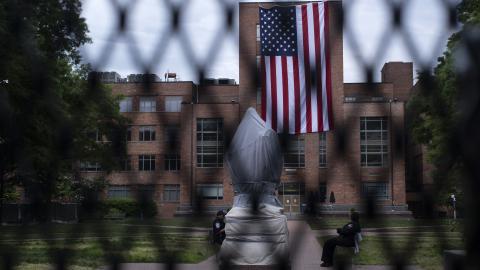

To discuss the future of Latvian foreign policy, Peter Rough will welcome Latvian Minister of Foreign Affairs Baiba Braže back to Hudson for a fireside chat.


Hudson will host an exclusive luncheon conversation with Dina Kallay, deputy assistant attorney general for international, policy and appellate at the Antitrust Division of the US Department of Justice.


Moderated by Senior Fellow Matthew Boyse, a 35-year foreign service officer, this conversation will explore the evolving landscape of American diplomacy and development.

